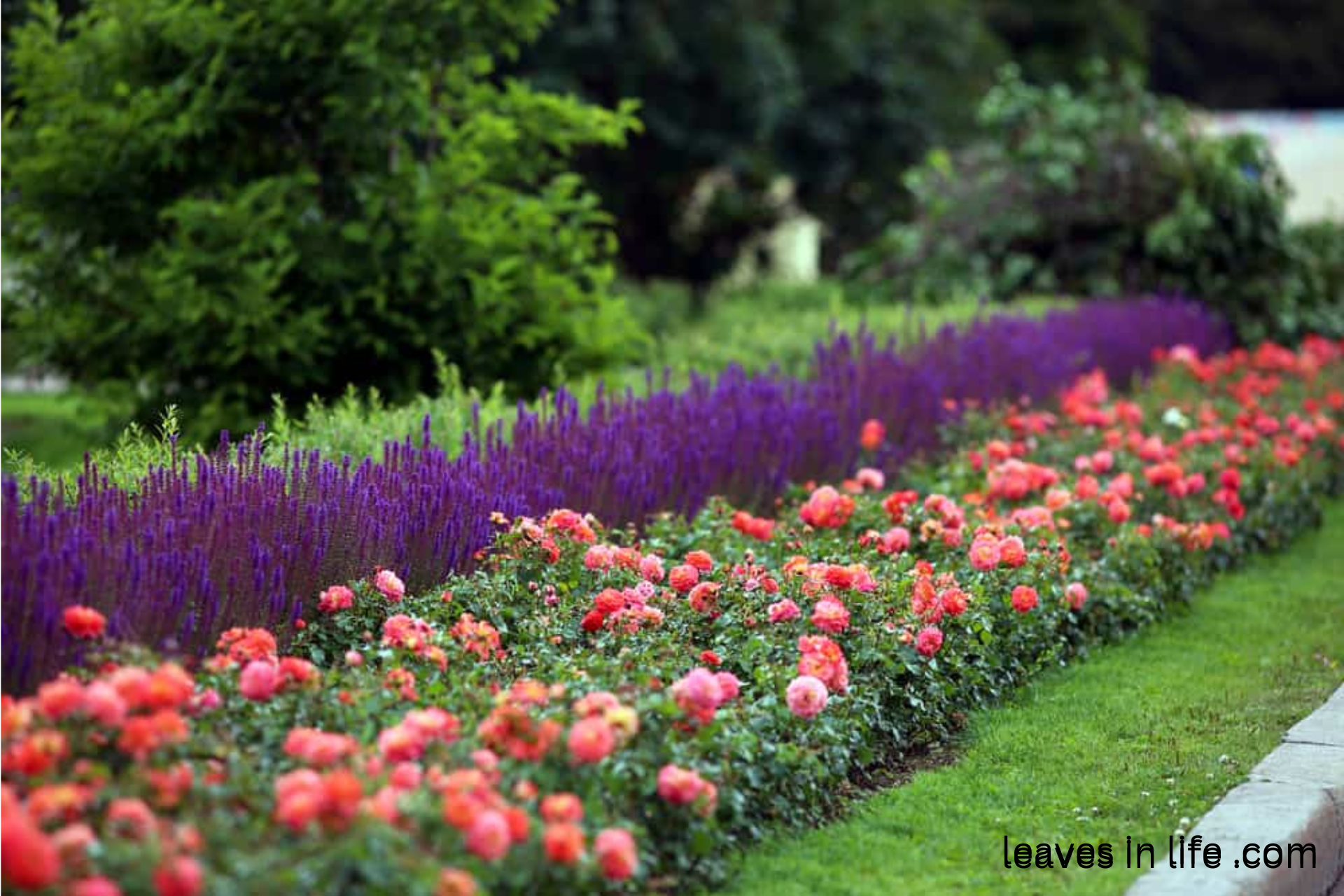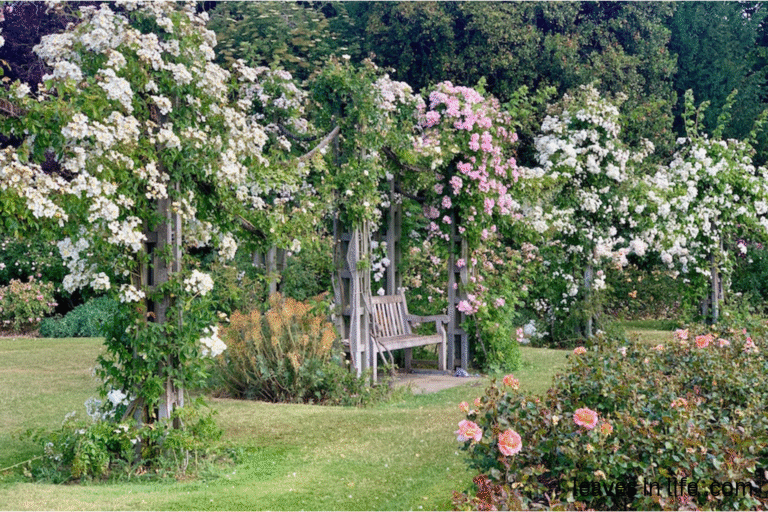Roses are everyone’s favourite flowers and can be easily found in garden of any plant lover. I also love roses, planted them in my little garden with other companion plants that are benevolent not only to them but also for each other and soil. In this article, you’ll discover the best companion plants for roses. I am going to share some companion plants of different varieties that you can blindly plant with roses and also share list of some common plants that you should prevent planting near roses.
Basic tips before planting roses (Rosa Rubiginosa) with other companion plants
- Choose a sunny spot: roses as they need at least 6 hours of daily sun
- Best period to plant roses: Late autumn to early spring i.e november to march .
- Soil care: Amend your soil with compost or aged manure to get well drained, rich soil which is necessary for best growth.
- Water wisely: When roses are young or during dry periods, you should water them properly and gently for deep moisture .Wet foliage at night can promote diseases so water them in early daytime .
- Protection: Use fencing to protect young roses from dear, rabbits and squirrels etc.
What to look for in companion plants for roses
Companion plants must have similar or contrasting needs for sun, water and soil conditioning as roses so both can grow without any extra management and maintenance.Here are all points you should consider in companion plants for roses:
- Light requirement: Both should require full sun, with roses needing at least six to eight hours of direct sunlight daily to bloom well is must quality to be present in companion plant, if it can not tolerate light intensity as rose plant, either it will die or you have to take extra maintenance steps for light intensity control.
- Soil type: Select plants that thrive in the same well-drained, slightly acidic, and fertile soil that roses prefer or a plant that is resilient to various soil types and conditions.
- Water needs: Companions plant for roses should also have moderate water needs to avoid competing with the roses’ consistent but not excessive watering requirements or you can opt for a plant that is drought resistant and can adapt different watering conditions.
- Root structure: Choose companion plants for roses with shallow or less aggressive root systems that won’t out-compete the roses for water and nutrients.
- Scent or nectar nature: Certain plants can help repel pests or attract beneficial insects that aid in pollination and pest management.
- Blooming seasons: choose companion plants for roses that can fill in the space and provide continuous colour after the first rose bloom, extending the period of charming spell in your garden.
- Growing habit: Select lower-growing Companion plant for roses or place companions at least 30-40 cm (12 inches) from the rose’s base to maintain good air circulation, which helps prevent fungal diseases like black spot and powdery mildew.
- Versatile gardening: Consider plants with different forms, textures, and colours. For instance, tall, spiky companion plants for roses like snapdragons or salvias provide a striking contrast to roses’ rounded blossoms. Plants with silver, pale green, or purple foliage can also beautifully accentuate rose blooms.
Best Companion plants for roses
Here is a detailed description of companion plants that thrive with roses including shrubs, annuals, perennials and biennials with various aspects like vibe, style, lifespan and management, and affects on each other.
“Best Shrubs as Companion Plants for Roses: Create a Stunning Outdoor Retreat”

Shrub name
Basic characteristics
| Lavender (Lavandula) | Pest Repellent, Attracts Pollinators, Foliage Contrast, Fragrant, |
| Cat-mint (Nepeta) | Classy Aromatic Appeal, Harmonious Colours, Pest Deterrent, fragnent , Same Soil and Sunlight Needs, Pollinator Attraction |
| Sage (Salvia) | Contrasting Colour , Long Bloom, Low maintenance, , Pollinator Friendly |
| Yarrow (Achillea millefolium) | Cottage Garden Aesthetic, Long-Lasting blooms, Similar Growing Conditions, , Pest Control,Attracts Pollinators, Low maintenance |
| Lady’s mantle (Alchimilla) | Soft & Romantic, Low Maintenance, similar growing conditions, Living Mulch, Weed Suppression and pest control |
| Weigela (Florida) | Same growing conditions, Contrasting vibe, Beautiful and contrasting colours |
| Clematis (Clematis.L) | Vertical Display, Similar Needs, Complementary Colours,Foliage Coverage, Extend Bloom Season |
| Spirea (Spiraea spp.) | Low maintenance, Charming foliage , contrasting vibe and colours, resistant and thriving |
| Thyme (Thymus vulgaris) | Low maintenance, pest control,attract pollinators, thrive with roses |
| Box-wood (Buxus sempervirens) | Ever green foliage, Thrive in same growing conditions, Deer repeller |
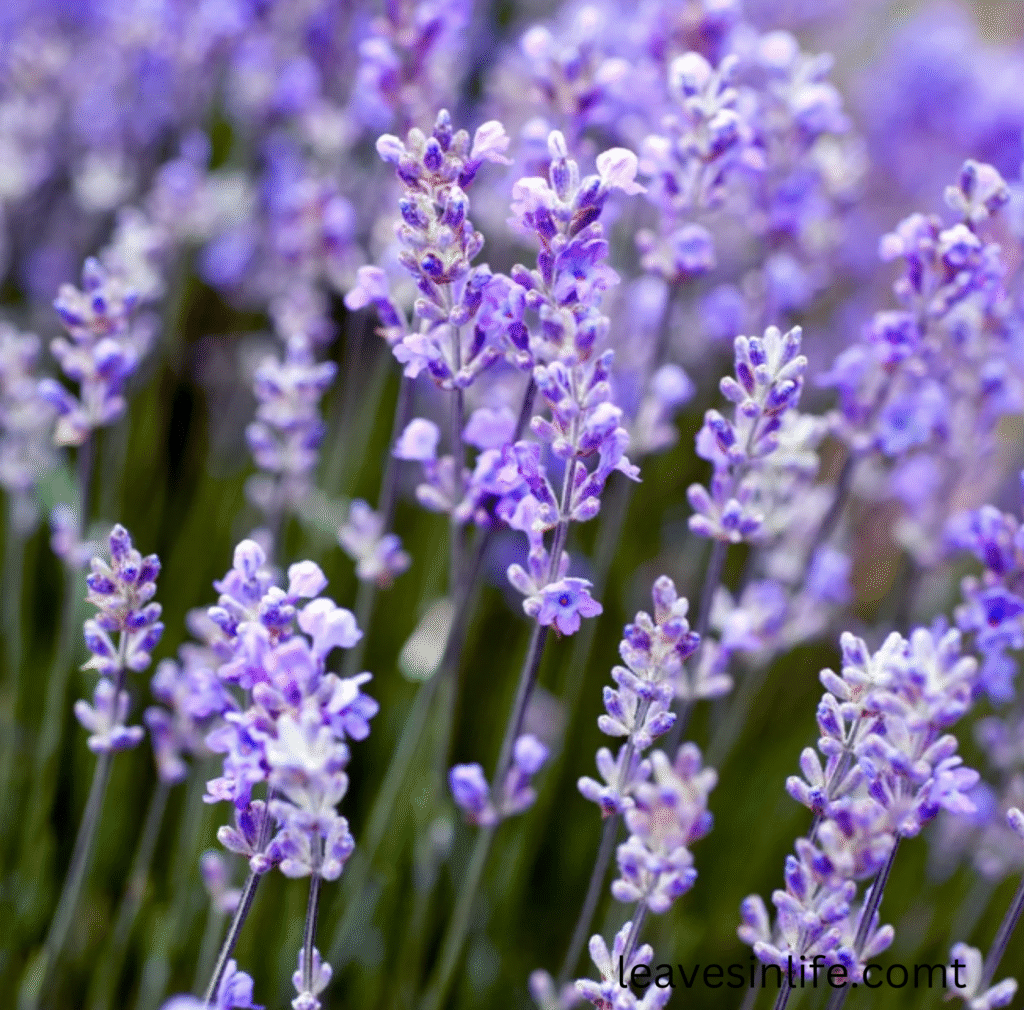
Lavender (Lavandula)
Zones: USDA Hardiness Zones 5 through 9, Spanish and French lavenders need warmer climates, thriving in Zones 8-11. (versatile according to its varieties)
Varieties: English, Lavandin (Hybrid), Spanish, and French
Vibe: Graceful and Elegant
Height and spread: English lavender (Lavandula angustifolia) typically grows 1–3 ft tall and spreads 1–3 ft wide, while French lavender (Lavandula dentata) reaches 2–4 ft tall and 2–3 ft wide. Spanish lavender (Lavandula stoechas) stays smaller at 1–2 ft tall and 1–2 ft wide, and hybrid lavenders (Lavandula × intermedia) generally grow 2–4 ft tall with a spread of 2–4 ft, offering a versatile range for different garden spaces.
Blooming period: Early-blooming varieties such as Lavandula angustifolia flower in late spring to early summer, mid-season types like Lavandula × intermedia bloom in mid-summer, while some long-blooming cultivars such as Lavandula stoechas can produce flowers from spring into fall.
Lavender: Fragrant Companion Plants for Roses
Pairing roses with aromatic herbs can enhance both beauty and garden health. Lavender (Lavandula) is one of the best companion plants for roses, offering fragrant foliage, long-lasting blooms, and a calming purple color that complements rose gardens beautifully.
Why Lavender is Ideal for Roses
Lavender attracts pollinators like bees and butterflies, supporting rose pollination, while its fragrant leaves can deter pests that affect roses. Its low-maintenance growth habit helps retain soil moisture and suppress weeds, making lavender a reliable choice among companion plants for roses.
Growing Habits of Lavender
Lavender varies in height and spread depending on the variety. Common types such as Lavandula angustifolia grow 18–36 in tall and 18–24 in wide, while larger varieties like Lavandula stoechas can reach 24–36 in tall and 24–36 in wide. Lavender thrives in full sun with well-draining soil, making it highly compatible with roses.
Best Season to Plant Lavender with Roses
The ideal time to plant lavender is spring or early fall, giving roots time to establish before extreme heat or frost. Its bloom period in late spring to mid-summer complements the flowering season of most roses.
Recommended Lavender Varieties for Roses
- Lavandula angustifolia ‘Hidcote’ – compact, deep purple flowers
- Lavandula angustifolia ‘Munstead’ – medium height, fragrant blooms
- Lavandula stoechas – taller, decorative “butterfly” blooms
__________________________________________________________________________________
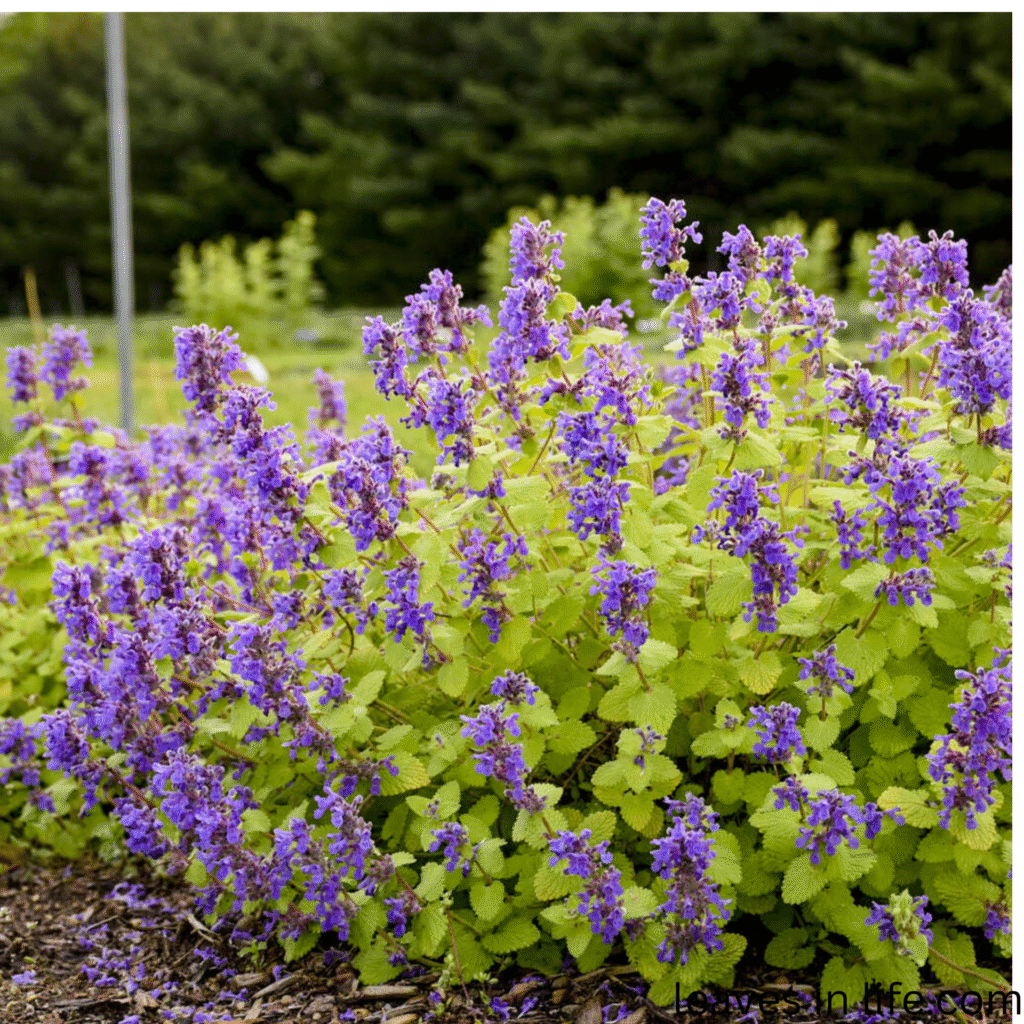
Cat-mint (Nepeta)
Zones: USDA Zones 3-9 (Versatile in nature)
Varieties: Upright clump-formers i.e Six Hills Giant , Spreading and Mounding i.e Catnip, Compact and Dwarf i.e little trudy
Vibe: Aesthetic, tranquil, Calming & Peaceful
Height and spread: Catmint size varies by type: Nepeta racemosa grows 12–18 in tall and 18–24 in wide, Nepeta × faassenii reaches 18–24 in tall and 24–30 in wide, while Nepeta ‘Walker’s Low’ can grow 24–30 in tall and spread 36–48 in wide.
Blooming period : Early-blooming varieties such as Nepeta racemosa flower in late spring to early summer, mid-season types like Nepeta × faassenii bloom in early to mid-summer, while long-blooming cultivars such as Nepeta ‘Walker’s Low’ can produce flowers from late spring into fall.
Catmint: Aromatic Companion Plants for Roses
Adding aromatic perennials to your rose garden enhances both beauty and health. Catmint (Nepeta) is a wonderful companion plant for roses, offering aromatic foliage, long-lasting blooms, and a soft, mounding habit that complements rose bushes beautifully.
Why Catmint is Ideal for Roses
Catmint attracts pollinators like bees and butterflies, supporting rose pollination, while its dense, low-growing foliage helps suppress weeds and retain soil moisture. Its aromatic leaves can also deter some pests, making catmint one of the most effective companion plants for roses for both aesthetics and plant health.
Growing Habits of Catmint
Catmint varies in height and spread depending on the variety. Upright types such as Nepeta ‘Walker’s Low’ grow 18–24 in tall and spread 24–36 in, while compact varieties like Nepeta faassenii reach 12–18 in tall with a spread of 18–24 in. Catmint thrives in full sun with well-draining soil, making it highly compatible companion plants for roses.
Best Season to Plant Catmint with Roses
The best time to plant catmint is spring or early fall, allowing roots to establish before extreme summer heat or winter cold. Its bloom period from late spring to early fall complements the flowering season of most roses, providing continuous color and texture.
Recommended Catmint Varieties for Roses
- Nepeta ‘Walker’s Low’ – tall, lavender-blue flowers, long bloom
- Nepeta faassenii – compact, gray-green foliage with purple flowers
- Nepeta racemosa – low-growing, aromatic foliage, violet-blue blooms
_______________________________________________________________________________________
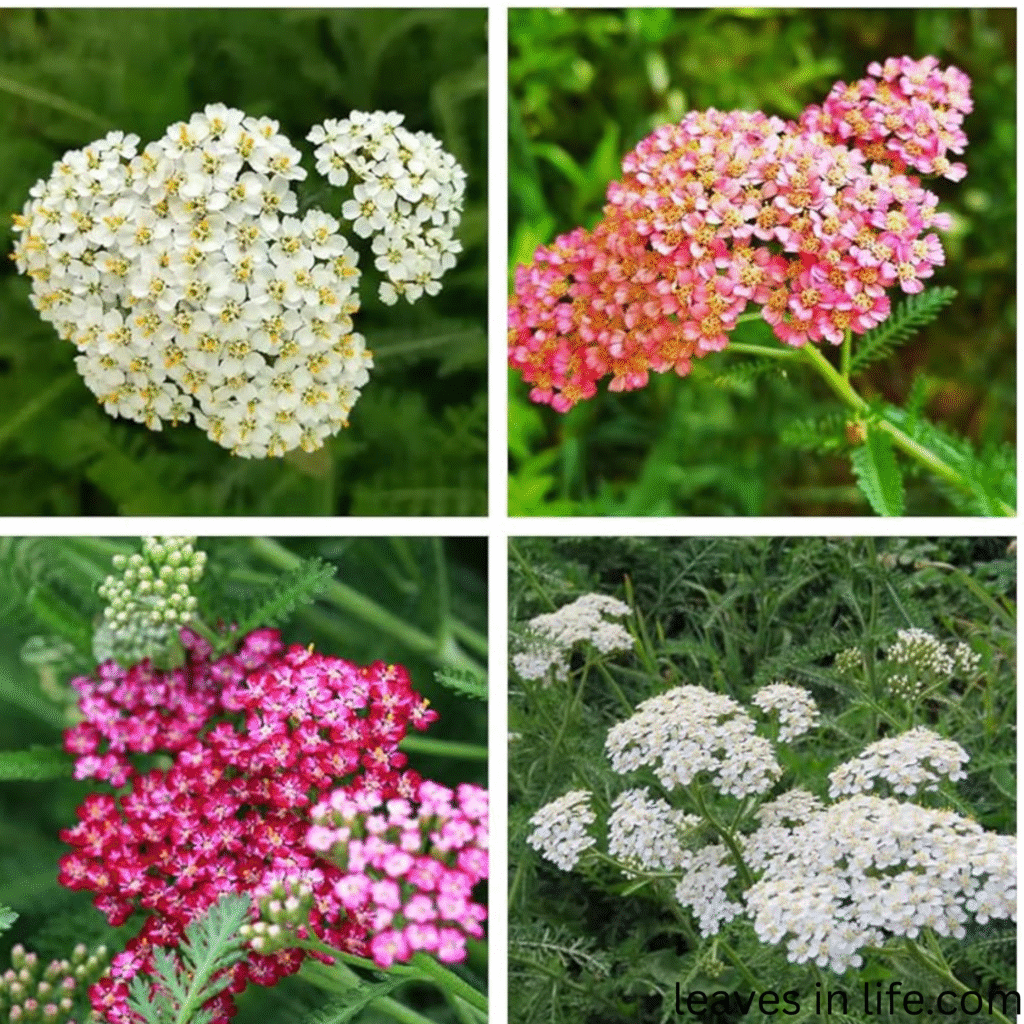
Yarrow (Achillea millefolium)
Zones: USDA Zones 3 through 9 (versatile in nature)
Varieties: Common Yarrow (Achillea millefolium): diverse range of colours and Fern-Leaf Yarrow( Achillea filipendulina): typically taller plants with often yellow, early-season blooms
Vibe: romentic, lucky resilience, protection, and healing
Spread and height: Yarrow size varies by type: Achillea millefolium grows 24–36 in tall and 18–24 in wide, Achillea filipendulina reaches 36–48 in tall and 24–36 in wide, while Achillea ‘Moonshine’ can grow 24–36 in tall and spread 18–24 in wide.
Blooming period: Early-blooming varieties such as Achillea millefolium flower in late spring to early summer, mid-season types like Achillea filipendulina bloom in early to mid-summer, while long-blooming cultivars such as Achillea ‘Moonshine’ can produce flowers from late spring into fall.
Yarrow: Hardy Companion Plants for Roses
Adding hardy perennials to your rose garden can enhance texture, color, and resilience. Yarrow (Achillea millefolium) is an excellent companion plant for roses, offering feathery foliage and clusters of long-lasting blooms that complement roses beautifully.
Why Yarrow is Ideal for Roses
Yarrow attracts pollinators like bees and butterflies, supporting rose pollination, while its dense foliage helps suppress weeds and retain soil moisture. Its drought-tolerant nature reduces garden maintenance, making yarrow one of the most practical companion plants for roses for both aesthetics and plant health.
Growing Habits of Yarrow
Yarrow varies in height and spread depending on the type. Common varieties such as Achillea millefolium ‘Paprika’ grow 24–36 in tall and 18–24 in wide, while dwarf types like Achillea millefolium ‘Little Moonshine’ reach 12–18 in tall with a similar spread. Yarrow thrives in full sun and well-draining soil, making it highly compatible with roses.
Best Season to Plant Yarrow with Roses
The ideal time to plant yarrow is spring or early fall, allowing roots to establish before extreme heat or winter cold. Its bloom period in early to mid-summer complements the flowering season of most roses, providing continuous color in the garden.
Recommended Yarrow Varieties for Roses
- Achillea millefolium ‘Paprika’ – bright red blooms, medium height
- Achillea millefolium ‘Moonshine’ – soft yellow flowers, tall variety
- Achillea millefolium ‘Little Moonshine’ – compact, pale yellow blooms
_____________________________________________________________________________________________
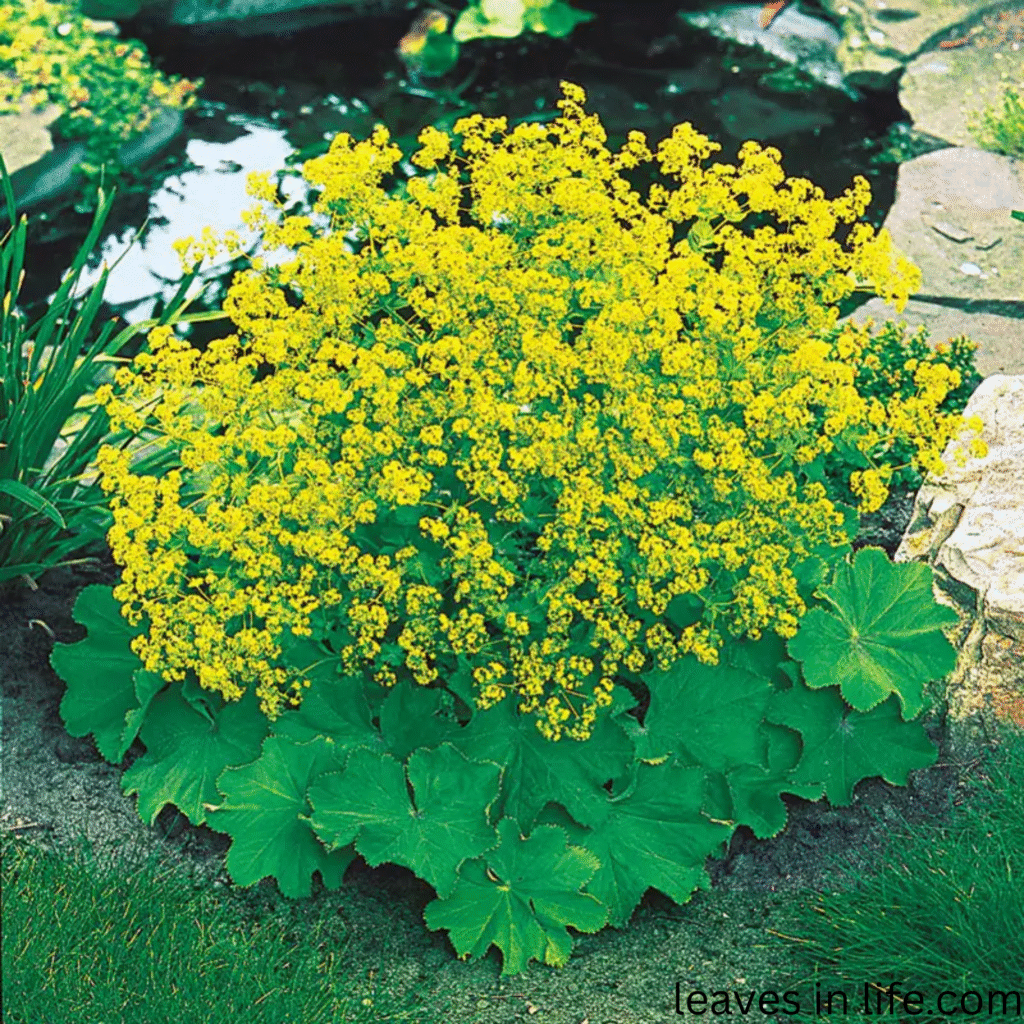
Lady’s mantle (Alchimilla)
Zones: USDA hardiness zones 3 through 8 ( tolerant and versatile in nature)
Varieties: Alchemilla mollis, Alchemilla vulgaris , Alchemilla alpina
Vibe: Feminine power, Graceful and delicate
Height and Spread:Lady’s mantle size varies by type: Alchemilla mollis grows 12–18 in tall and 18–24 in wide, while Alchemilla erythropoda reaches 8–12 in tall and spreads 12–18 in wide.
Blooming period: Most varieties, including Alchemilla mollis, bloom in late spring to early summer, while some cultivars like Alchemilla erythropoda may extend flowering into mid-summer.
Lady’s Mantle: Soft Companion Plants for Roses
Adding foliage-rich perennials to your rose garden can enhance texture and color contrast. Lady’s Mantle (Alchemilla mollis) is an excellent companion plant for roses, offering soft, rounded leaves and delicate flowers that complement roses beautifully.
Why Lady’s Mantle is Ideal for Roses
Lady’s Mantle provides a lush, low-growing carpet around rose bushes, helping to suppress weeds, retain soil moisture, and protect rose roots. Its tiny, chartreuse flowers attract pollinators like bees and butterflies, supporting rose pollination. These qualities make lady’s mantle one of the most practical companion plants for roses.
Growing Habits of Lady’s Mantle
Lady’s Mantle typically grows 12–18 in tall with a spread of 18–24 in. It thrives in full sun to partial shade and well-draining soil, making it highly compatible with roses. Its soft, rounded foliage creates a natural mulch effect, keeping the soil cool and moist around rose roots.
Best Season to Plant Lady’s Mantle with Roses
The best time to plant lady’s mantle is spring or early fall, allowing roots to establish before extreme heat or cold. Its bloom period in late spring to early summer complements the flowering season of most roses.
Recommended Lady’s Mantle Varieties for Roses
- Alchemilla mollis – soft, rounded leaves with chartreuse flowers
- Alchemilla erythropoda – compact, silvery foliage with tiny green flowers
- Alchemilla xanthochlora – mid-sized, long-blooming variety
_______________________________________________________________________________________________
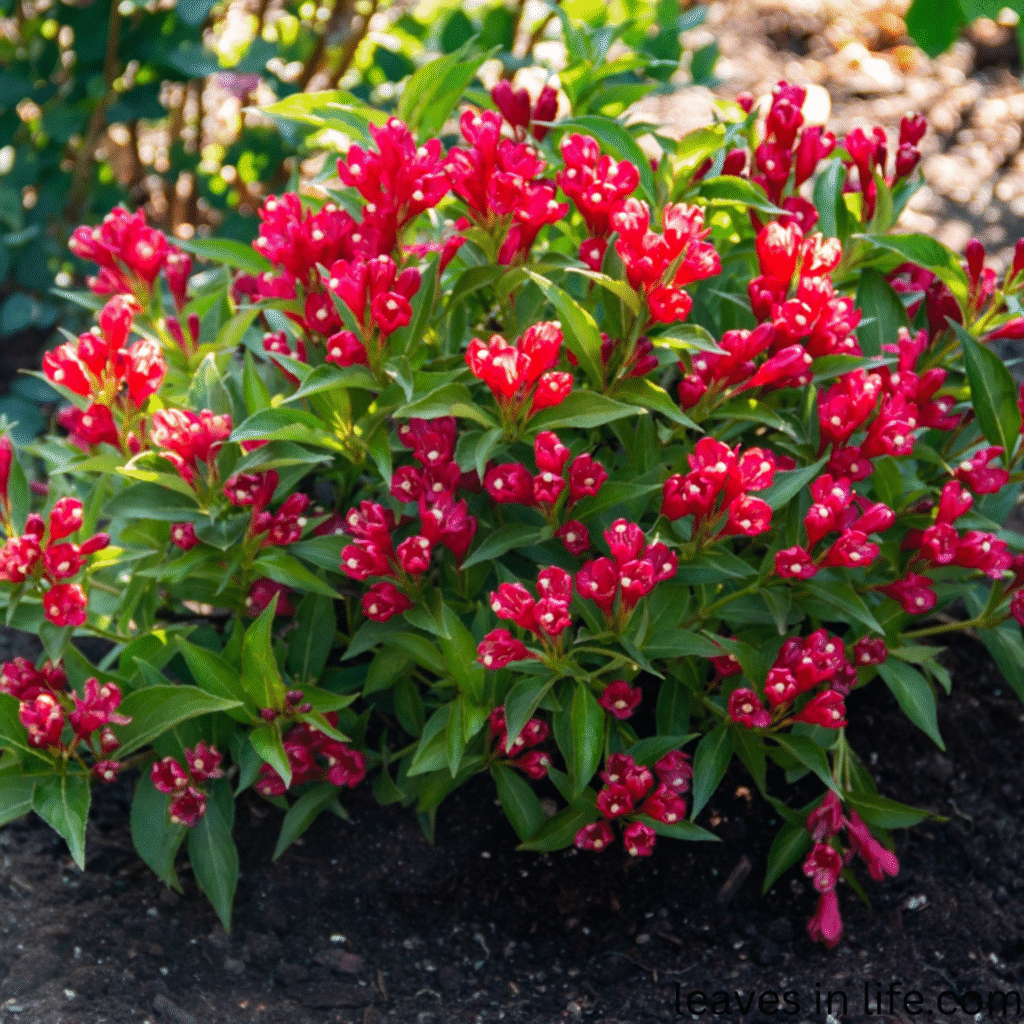
Weigela (Florida)
Zones: USDA Zones 4 through 8
Varieties: About 150-200 different varieties that range in size from dwarf to large.
Vibe: Traditional, Charming and Romentic.
Height and Spread: Weigela size varies by type: Weigela florida grows 3–5 ft tall and 3–5 ft wide, while reblooming cultivars like Weigela ‘Sonic Bloom’ can reach 4–6 ft tall and spread 4–6 ft.
Blooming period: Most varieties, such as Weigela florida, bloom in late spring to early summer, while reblooming cultivars like Weigela ‘Sonic Bloom’ can produce flowers again in mid- to late summer.
Weigela: Vibrant Companion Plants for Roses
Adding flowering shrubs to your rose garden can enhance color, texture, and seasonal interest. Weigela is an excellent companion plant for roses, offering colorful blooms, attractive foliage, and a low-maintenance growth habit that complements roses beautifully.
Why Weigela is Ideal for Roses
Weigela provides a soft, mounding contrast to the upright form of roses. Its flowers attract pollinators like bees and butterflies, supporting rose pollination, while the foliage helps retain soil moisture and suppress weeds. These qualities make weigela one of the most reliable for roses for both aesthetics and garden health.
Growing Habits of Weigela
Weigela varies in height and spread depending on the variety. Dwarf varieties such as Weigela ‘Minuet’ grow 2–3 ft tall and 2–3 ft wide, while larger varieties like Weigela florida ‘Wine & Roses’ reach 4–6 ft tall and 4–6 ft wide. Weigela thrives in full sun to partial shade and well-draining soil, making it highly compatible with roses.
Best Season to Plant Weigela with Roses
The ideal time to plant weigela is spring or early fall, allowing roots to establish before extreme heat or cold. Weigela blooms in late spring to early summer, complementing the flowering period of most roses.
Recommended Weigela Varieties for Roses
- Weigela ‘Minuet’ – compact, pink flowers, great for borders
- Weigela florida ‘Wine & Roses’ – medium height, red blooms with purple foliage
- Weigela florida ‘Pink Princess’ – vibrant pink flowers, mid-sized shrub
____________________________________________________________________________________________
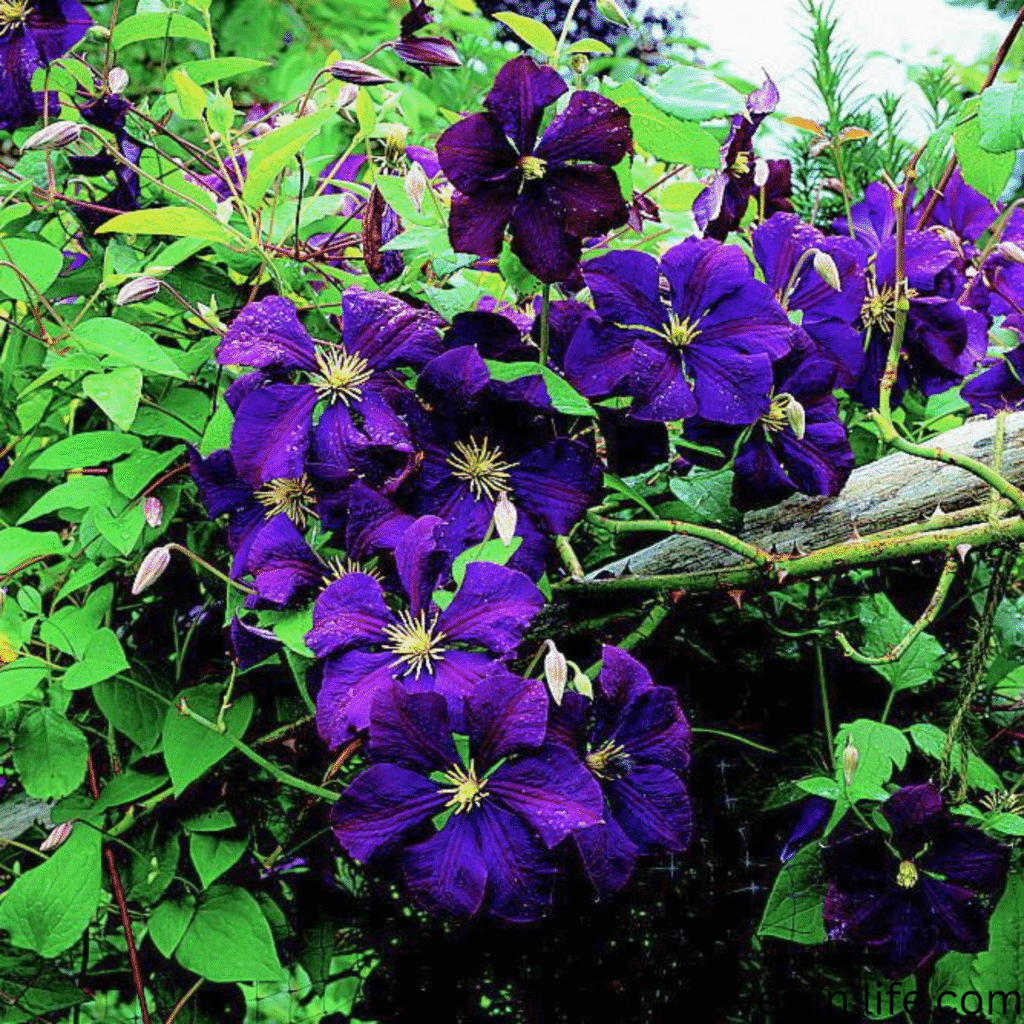
Clematis (Clematis.L)
Zones: USDA Hardiness Zones 4-9 to Zone 3 and Zone 10 for some varieties.
Varieties:A versatile plant having catagories based on early-flowering Group 1, late-flowering Group 3, evergreen, herbaceous, and Viticella (like ‘Etoile Violette clematis
Vibe: Delicate ,Ingenuity and Deep Connections to Ambition and Goals.
Height and spread: Clematis montana grows 8–12 ft tall and 3–4 ft wide, Clematis ‘Nelly Moser’ reaches 6–10 ft tall and 3–4 ft wide, while Clematis ‘Jackmanii’ can climb 10–20 ft tall and spread 3–6 ft.
Blooming period: Early-flowering varieties such as Clematis montana bloom in spring, large-flowered hybrids like Clematis ‘Nelly Moser’ flower in late spring to early summer (often with a second flush), while late-flowering types such as Clematis ‘Jackmanii’ bloom from summer into fall.
Clematis: Stunning Companion Plants for Roses
Pairing roses with climbing plants can create a layered, visually striking garden. Clematis is one of the best companion plants for roses, offering vibrant flowers and elegant vines that complement rose blooms beautifully.
Why Clematis is Ideal for Roses
Clematis adds vertical interest to rose gardens, providing a striking backdrop for rose flowers. Its climbing habit allows it to intertwine with rose stems without competing aggressively for nutrients. The flowers attract pollinators like bees and butterflies, supporting rose health and bloom performance. These qualities make clematis one of the top companion plants for roses.
Growing Habits of Clematis
Clematis varies in size depending on the type. Early-flowering varieties such as Clematis montana grow 8–12 ft tall and spread 3–4 ft, while large-flowered hybrids like Clematis ‘Nelly Moser’ reach 6–10 ft tall with a 3–4 ft spread. Late-flowering types such as Clematis ‘Jackmanii’ can climb 10–20 ft tall and spread 3–6 ft. Clematis thrives in full sun with shaded roots, making it highly compatible with roses.
Best Season to Plant Clematis with Roses
The best time to plant clematis is spring or early fall, allowing roots to establish before extreme heat or cold. This ensures strong growth and blooms that complement roses during their flowering season.
Recommended Clematis Varieties for Roses
- Clematis montana – early spring blooms, vigorous climber
- Clematis ‘Nelly Moser’ – large pale pink blooms, late spring to early summer
- Clematis ‘Jackmanii’ – deep purple flowers, summer into fall
________________________________________________________________________________________________
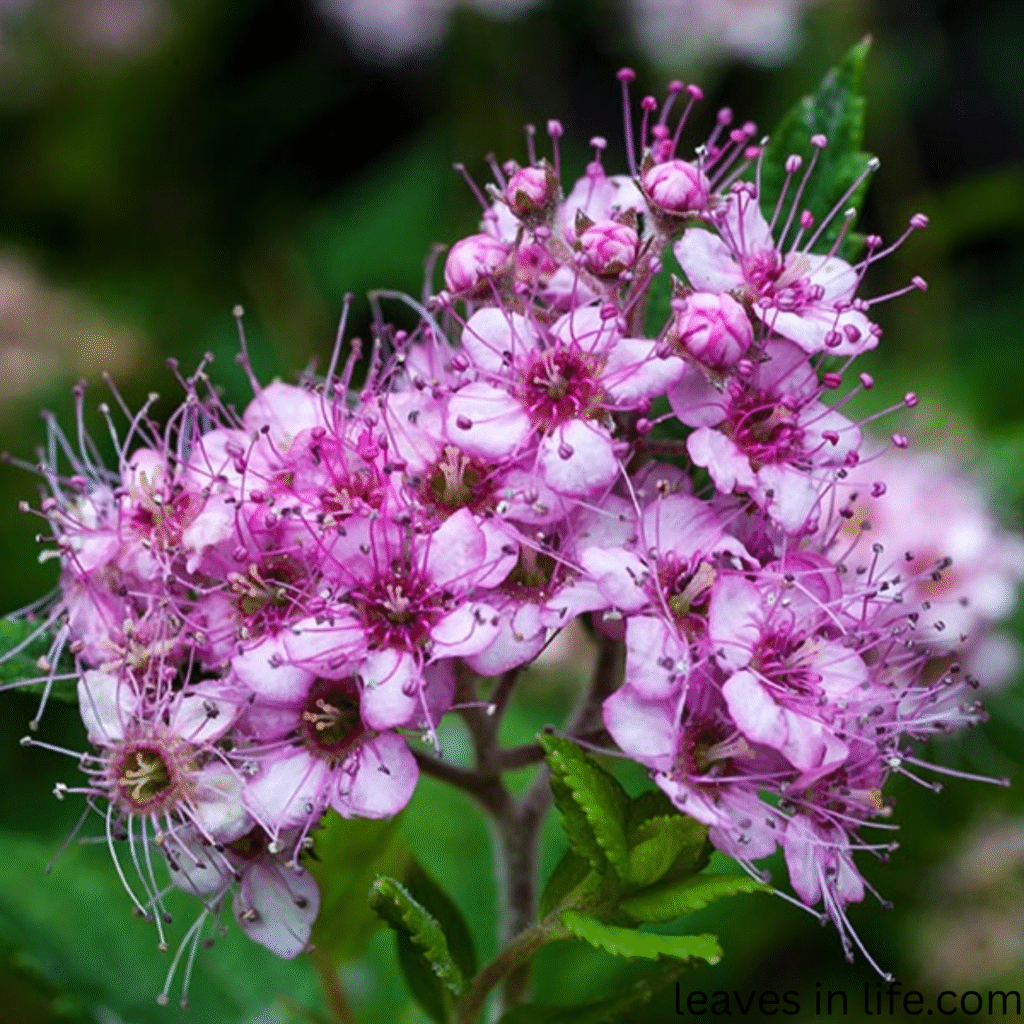
Spirea (Spiraea spp.)
Zones: Most spirea are hardy in USDA Zones 3-8, with some varieties extending to Zones 3-9
Varieties:Japanese Spirea (Spiraea japonica), Bridal Wreath Spirea (Spiraea prunifolia or x vanhouteii), Birchleaf Spirea (Spiraea betulifolia), Nippon Spirea (Spiraea nipponica).
Vibe: Delicate and charming with simple vibrant beauty
Height and Spread: Range from small shrubs under 1 meter (3 feet) to large specimens up to 2.5 meters (8 feet) tall and wide
Blooming period:Spiraea nipponica grows 3–4 ft tall and 3–4 ft wide, Spiraea japonica reaches 2–3 ft tall and 3–4 ft wide, while reblooming cultivars like Spiraea ‘Magic Carpet’ can grow 2–3 ft tall and spread 3–5 ft.
Spirea: Elegant Companion Plants for Roses
Adding flowering shrubs to your rose garden can enhance structure, color, and seasonal interest. Spirea is an excellent companion plant for roses, offering delicate foliage, cascading blooms, and low-maintenance growth that complements roses beautifully.
Why Spirea is Ideal for Roses
Spirea provides a soft, rounded contrast to the upright and bushy forms of roses. Its flowers attract pollinators like bees and butterflies, supporting rose pollination, while its foliage helps retain soil moisture and suppress weeds. These qualities make spirea one of the most reliable companion plants for roses for both aesthetics and garden health.
Growing Habits of Spirea
Spirea varies in height and spread depending on the type. Low-growing varieties such as Spirea japonica ‘Little Princess’ reach 1–2 ft tall and 1–2 ft wide, while larger varieties like Spirea japonica ‘Goldflame’ grow 3–5 ft tall with a 3–5 ft spread. Spirea thrives in full sun to partial shade and well-draining soil, making it highly compatible companion plants for roses.
Best Season to Plant Spirea with Roses
The ideal time to plant spirea is spring or early fall, allowing roots to establish before extreme summer heat or winter cold. Spirea blooms in late spring to early summer, complementing the flowering period of most roses.
Recommended Spirea Varieties for Roses
Spirea vanhouttei – taller variety, white cascading blooms
Spirea japonica ‘Little Princess’ – low-growing, pink blooms
Spirea japonica ‘Goldflame’ – mid-height, red foliage with pink flowers
_____________________________________________________________________________________________________
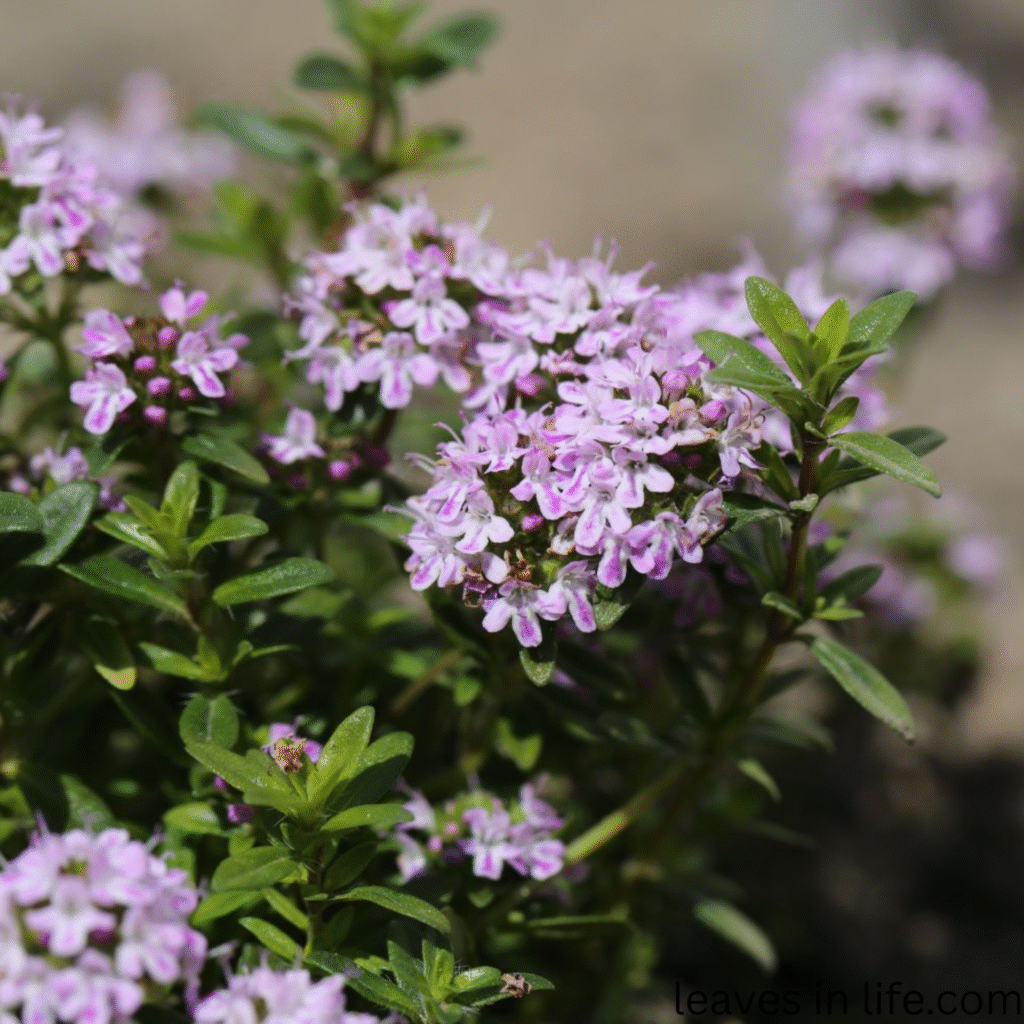
Thyme (Thymus vulgaris)
Zones: USDA Hardiness Zones 5-9, though some varieties can grow in Zone 4
Varieties: Common Thyme (also known as French or English thyme) and Lemon Thyme, Woolly Thyme, Creeping Thyme, Caraway Thyme and Orange Balsam Thyme
Vibe: energetic, clear, courageous, Homey and symbolic
Height and Spread: Thyme size varies by type: Thymus vulgaris grows 6–12 in tall and 12–18 in wide, Thymus citriodorus reaches 8–14 in tall and 12–20 in wide, while groundcover types like Thymus serpyllum can grow 4–6 in tall and spread 12–24 in wide.
Blooming period: Early-flowering varieties such as Thymus vulgaris bloom in late spring to early summer, mid-season types like Thymus citriodorus flower in early to mid-summer, while long-blooming cultivars such as Thymus serpyllum can produce flowers from late spring into fall.
Thyme: Aromatic Companion Plants for Roses
Enhancing your rose garden with aromatic herbs can improve both aesthetics and plant health. Thyme (Thymus) is a wonderful companion plants for roses, providing low-growing foliage, fragrant aromas, and attractive blooms that complement rose beds beautifully.
Why Thyme is Ideal for Roses
Thyme acts as a natural ground cover around roses, helping to suppress weeds, retain soil moisture, and protect rose roots. Its fragrant leaves deter some pests, while the small blooms attract pollinators like bees and butterflies, supporting rose pollination. .
Growing Habits of Thyme
Thyme varies in height and spread depending on the type. Common varieties such as Thymus vulgaris grow 6–12 in tall and spread 12–18 in, while creeping types like Thymus serpyllum reach 4–6 in tall and spread 12–24 in. Thyme thrives in full sun with well-draining soil, making it highly compatible with roses.
Best Season to Plant Thyme with Roses
The best time to plant thyme is spring or early fall, allowing the roots to establish before extreme summer heat or winter cold. When planted around roses, thyme provides a continuous bloom carpet that enhances color and texture in the garden.
Recommended Thyme Varieties for Roses
Thymus serpyllum – creeping thyme, low ground cover, purple blooms
Thymus vulgaris – classic culinary thyme, upright growth
Thymus citriodorus – lemon-scented thyme, spreading habit
______________________________________________________________________________________________________
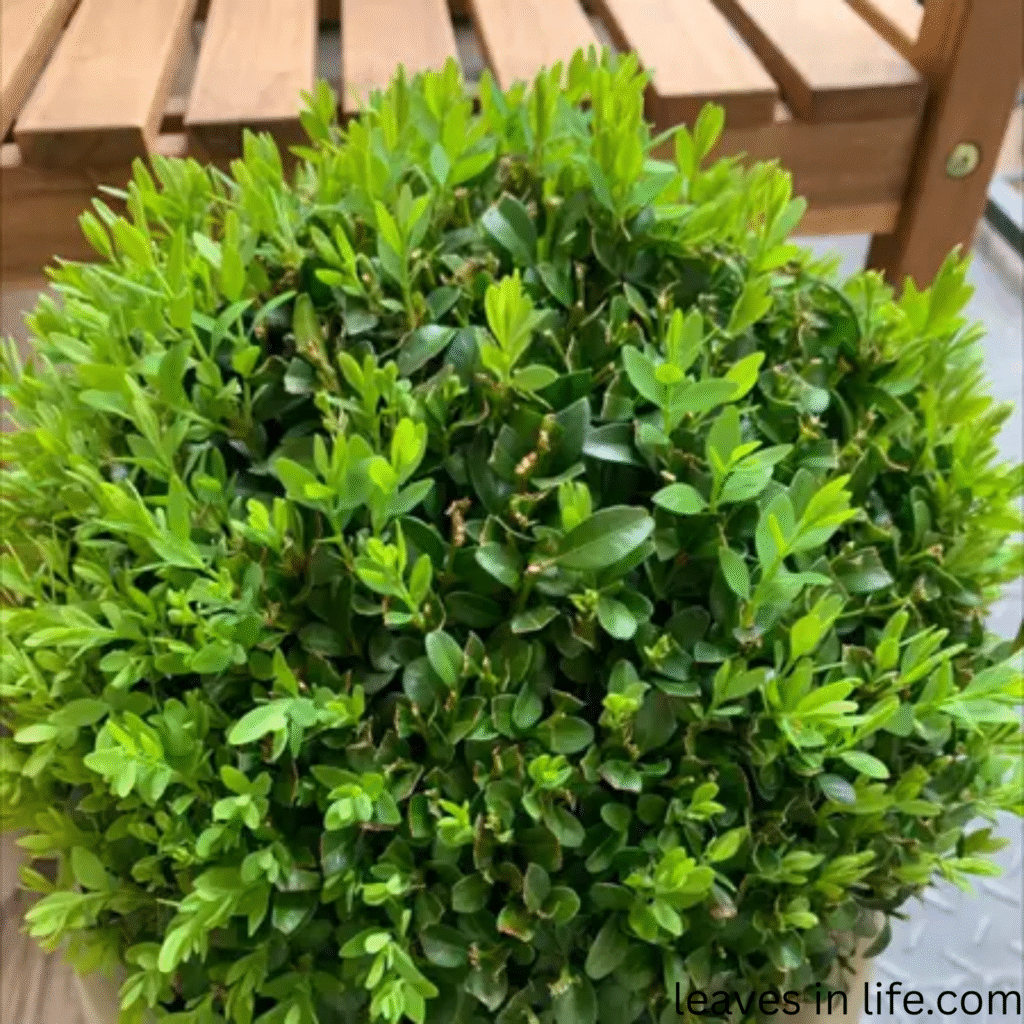
Box-wood (Buxus sempervirens)
Zones: USDA Plant Hardiness Zones 5 through 9
Varieties:American Boxwood (Buxus sempervirens), English Boxwood like Suffruticosa, Green Velvet (Buxus sinica × curtidensa) and Winter Gem (Buxus microphylla × sempervirens ) Other notable varieties include upright forms like Green Mountain and Dee Runk, Baby Gem for borders, and Variegated Boxwood with ornamental foliage..
Vibe: Timeless elegant, structural, and versatile
Height and Spread: Buxus sempervirens grows 5–10 ft tall and 5–10 ft wide, while dwarf varieties like Buxus microphylla ‘Wintergreen’ reach 2–3 ft tall and spread 2–3 ft, making them suitable for hedges, borders, and topiary.
Blooming period: Boxwood blooms quietly in late spring, usually April to May. It is basically famous for its lush green leaves not flowers. The blooming time is also a good reminder to prune and feed the plant, keeping it healthy and full for the rest of the year.
Boxwood: Evergreen Companion Plants for Roses
Pairing roses with evergreen companions can enhance structure and year-round interest in your garden. Boxwood (Buxus) are excellent companion plants for roses, providing a formal, tidy backdrop that highlights the colours and shapes of rose blooms.
Why Boxwood is Ideal for Roses
Boxwood adds structure and evergreen foliage to rose beds, helping to frame and elevate the visual appeal of roses. Its dense growth suppresses weeds, retains soil moisture, and creates a microclimate that protects rose roots. This makes boxwood one of the most reliable companion plants for roses for both aesthetics and garden health.
Growing Habits of Boxwood
Boxwood varies in size depending on the type. Common varieties such as Buxus sempervirens grow 5–10 ft tall and 5–10 ft wide, while dwarf types like Buxus microphylla ‘Wintergreen’ reach 2–3 ft tall and spread 2–3 ft, making them perfect for hedges, borders, or topiary accents alongside roses. Boxwood thrives in full sun to partial shade and well-draining soil.
Best Season to Plant Boxwood with Roses
The ideal time to plant boxwood is spring or early fall, giving roots time to establish before extreme summer heat or winter cold. Once established, boxwood provides year-round greenery and structure, complementing the seasonal blooms of roses.
Recommended Boxwood Varieties for Roses
Buxus ‘Green Velvet’ – rounded, dense growth, perfect for borders
Buxus sempervirens – classic tall hedges, slow-growing
Buxus microphylla ‘Wintergreen’ – compact, dwarf variety, low-maintenance
____________________________________________________________________________________________________
“Perennial Companion Plants for Roses: Easy, Beautiful Pairings for Every Season”
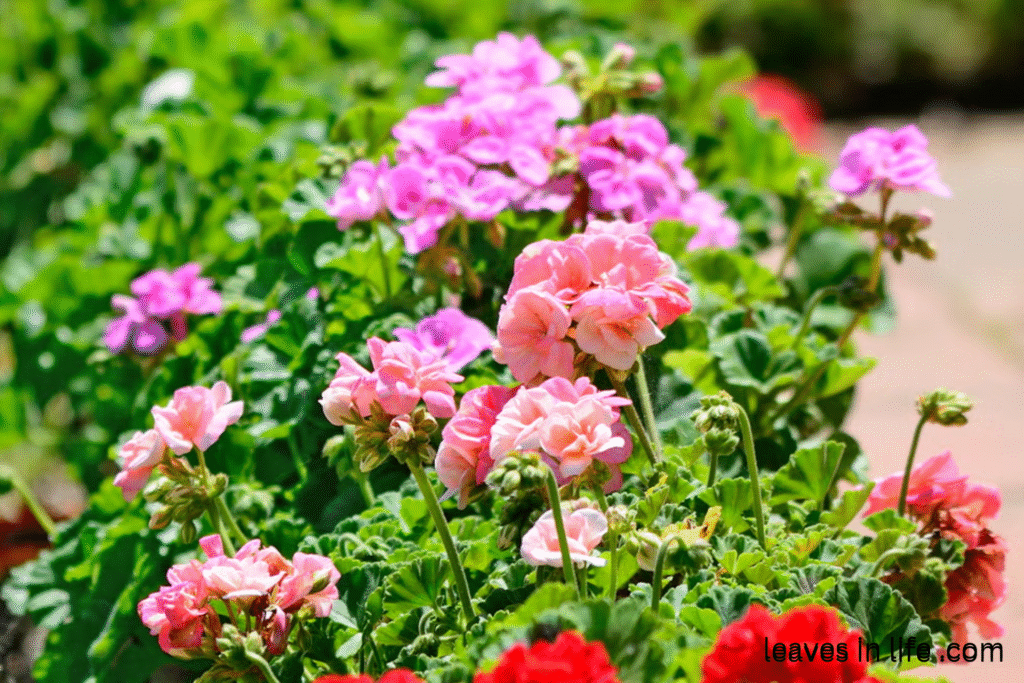
| Crane’s-bill (Geranium) | soft, romantic, wildflower, Ground Cover, Foliage Contrast, Extended Blooming, Low Maintenance. |
| Foxglove (Digitalis) | Elegant, tubular flowers, romantic, Tall, spire-like growth adds vertical interest, Foliage Contrast, Pollinator Magnet. |
| Bellflower (Campanula) | Delicate, bell-shaped blooms, fresh, airy, romantic touch, Pollinator Friendly, Foliage Contrast, Best companion plants for roses. |
| Blooming clematis (Clematis armandii) | Large, star-like blooms, Light, airy foliage, Pollinator Friendly, add vertical interest. |
| Delphinium (Delphinium elatum) | classic, lacy green foliage, Best companion plants for roses, Tall, upright spikes, Pollinator Friendly. |
| Lily (Lilium) | Romantic and Smooth vibe, lance-shaped leaves, Upright stems with elegant blooms, Pollinator Friendly. |
| tickseed (Coreopsis spp.) | Bright and joyful vibe, Compact, airy plants, Fine-thread-like and soft green foliage, Pollinator Friendly. |
| Alyssum (Lobularia maritima) | Soft and charming vibe, Fine-delicate green foliage, Low-growing, trailing plants, honey-like scent, Pollinator Friendly. |
| Snapdragons (Antirrhinum) | Bright, cheerful and romantic vibe, Slender-green foliage, dwarf to tall varieties, have a light and sweet scent, Pollinator Friendly. |
| Marigolds (Tagetes) | Bright, cheerful, sunny and vibrant vibe, Compact to medium-sized mounding plants,Best companion plants for roses, Fern-like, aromatic foliage, Distinct-spicy scent, Pest Repellent, pollinator friendly. |
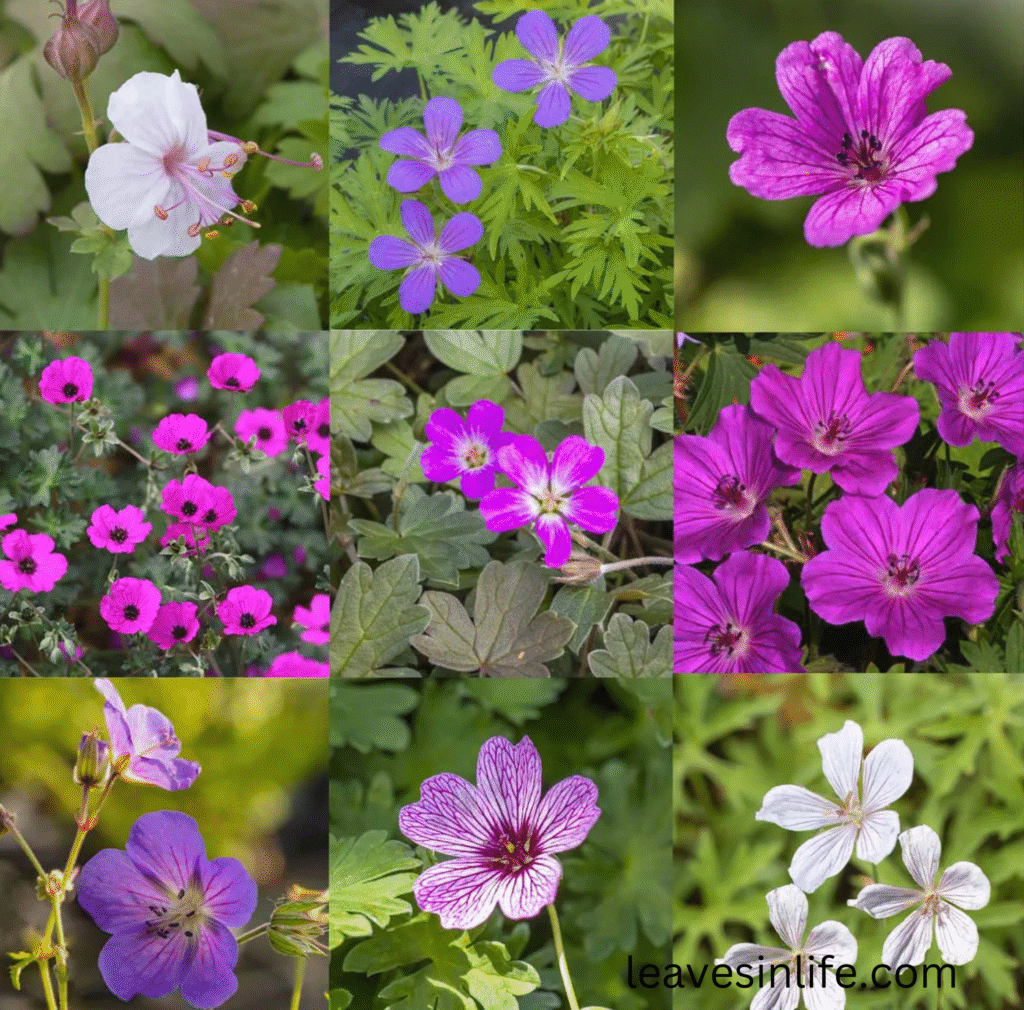
Cranesbill (Geranium)
Zones: USDA Zones 4 – 8, though some cultivars may extend to zone 3 or 9
Varieties: ‘Rozanne’( long blooming), ‘Ann Folkard’ (low-growing, spreading), Geranium macrorrhizum (ground cover), Geranium psilostemon (taller, large-flowered), Geranium phaeum, Geranium sanguineum.
Vibe: Delicate, airy, soft, romantic, natural, timeless, graceful, charming.
Height and spread: Cranesbill (hardy geraniums) generally grow 12–24 in tall and 12–36 in wide, with compact varieties staying closer to 8–12 in tall and spreading about 12–18 in wide.
Blooming period: Early-blooming cranesbills such as Geranium phaeum flower from late spring to early summer, summer-blooming types like Geranium pratense peak in early to mid-summer, while long-blooming varieties such as Geranium ‘Rozanne’ continue producing flowers from late spring well into fall.
Cranesbill: The Best Companion Plants for Roses
One of the most reliable and attractive companion plants for roses is cranesbill (Geranium). This hardy perennial not only complements roses visually but also improves the overall garden ecosystem.
Why Cranesbill is the Ideal Companion for Roses
Cranesbill is a perfect companion plants for roses because it offers low-maintenance growth, long-lasting flowers, and a mounding habit that fills in the base of rose bushes. Its dense foliage helps suppress weeds, retain soil moisture, and protect rose roots, while its colourful blooms attract pollinators like bees and butterflies, improving rose pollination naturally.
Growing Habits of Cranesbill
Cranesbill generally grows 12–24 inches tall and spreads 12–36 inches, depending on the variety. It thrives in full sun to partial shade, making it highly adaptable alongside most rose varieties. Its long-lasting blooms range from soft blues and pinks to deep magentas, providing a beautiful contrast to roses throughout the growing season.
Best Season to Plant Cranesbill with Roses
The optimal time to plant cranesbill is spring or early fall. Planting during these seasons allows the roots to establish before the summer heat or winter chill, ensuring healthy growth and continuous blooms alongside your roses.
Benefits for Roses, Soil, and Garden Surroundings
Cranesbill enhances rose gardens by improving soil structure, reducing erosion, and creating a natural mulch effect with its foliage. Its pest-resistant nature lowers the risk of infestations, while its flowers support a pollinator-friendly garden, encouraging biodiversity.
Recommended Cranesbill Varieties for Roses
- Geranium ‘Rozanne’ – long-blooming violet-blue flowers
- Geranium ‘Johnson’s Blue’ – classic sky-blue blooms
- Geranium ‘Brookside’ – vivid blue flowers with a reddish eye
- Geranium ‘Max Frei’ – deep magenta compact blooms
- Geranium ‘Ann Folkard’ – bright magenta flowers with a sprawling habit
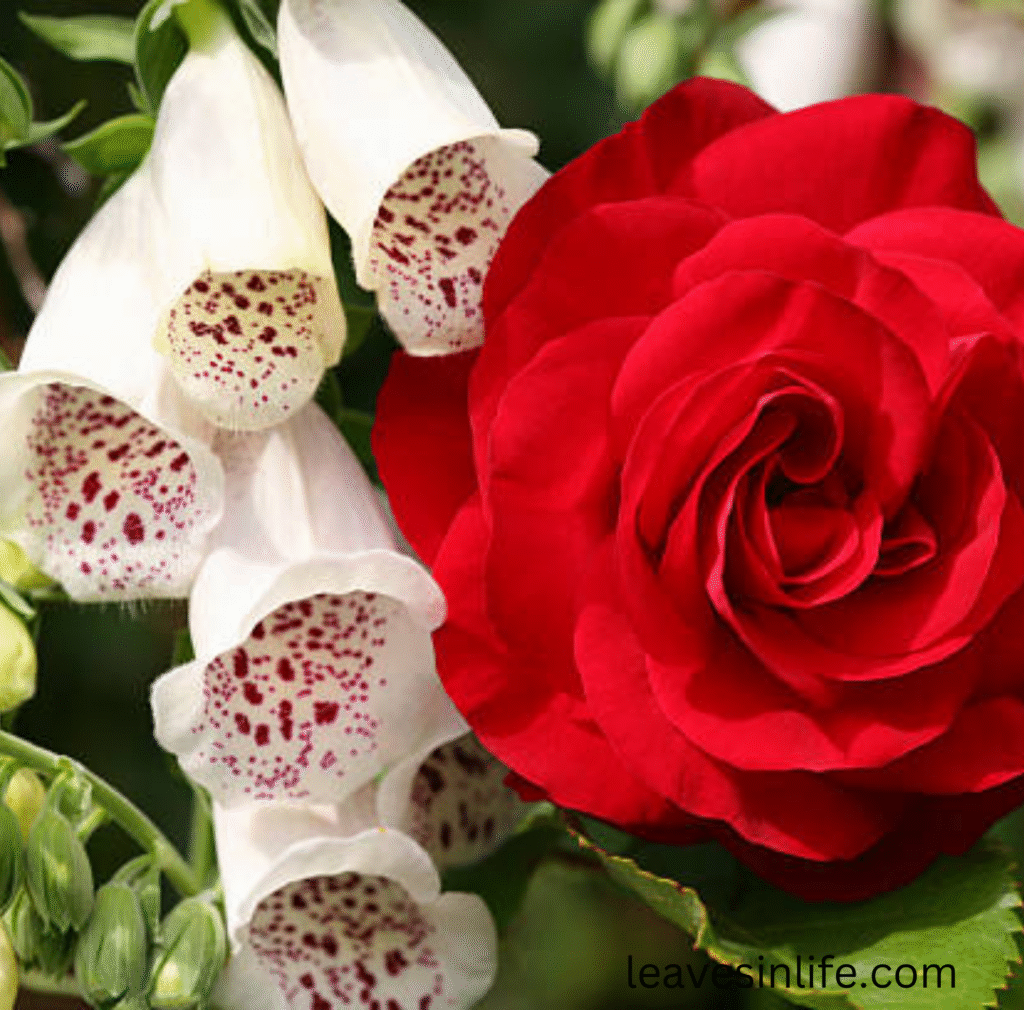
Foxglove (Digitalis)
Zones: Foxgloves typically grow best in USDA hardiness zones 4–9. some species are are versatile which overall grow under hardiness zones 3-9.
Varieties: Digitalis purpurea (Common Foxglove), Digitalis grandiflora (Yellow Foxglove), Digitalis ferruginea (Rusty Foxglove).
Vibe: cottage-garden, romantic, vertical, whimsical, vintage, enchanting,,
Height and spread: Foxgloves generally grow 2–5 ft tall and 1–2 ft wide, with dwarf types around 1–2 ft tall and 1 ft wide, while some large perennial varieties can reach up to 6 ft tall and 2 ft wide.
Blooming period: Perennial foxgloves such as Digitalis grandiflora bloom in early to mid-summer, while longer-blooming hybrids like Digitalis ‘Camelot’ can flower from late spring into early fall.
Foxgloves: The Perfect Companion Plants for Roses
Among the best companion plants for roses are foxgloves (Digitalis). With their tall, elegant spikes and long-lasting blooms, foxgloves add vertical interest and charm to any rose garden while providing practical benefits.
Why Foxgloves are Ideal for Roses
Foxgloves offer multiple advantages when planted alongside roses. Their towering spires create a dramatic backdrop for rose blooms, while their dense foliage helps protect rose roots and suppress weeds. Additionally, foxgloves attract pollinators like bees and butterflies, which improves the health and flowering of your roses, making them one of the most effective companion plants for roses.
Growing Habits of Foxgloves
Perennial foxgloves generally grow 2–5 ft tall and spread 1–2 ft wide, depending on the variety. They thrive in full sun to partial shade and well-draining soil, similar to roses, ensuring easy compatibility in rose beds. Foxgloves are low-maintenance and naturally resistant to many pests, allowing them to flourish alongside roses with minimal care.
Best Season to Plant Foxgloves with Roses
The ideal time to plant foxgloves is spring or early fall, giving the roots time to establish before extreme summer heat or winter cold. Biennial foxgloves will flower in their second year, while perennial varieties will return each year, providing consistent vertical colour next to your roses.
Benefits for Roses, Soil, and Garden Surroundings
Foxgloves improve the microclimate around roses, shading roots, reducing soil erosion, and suppressing weeds. Their upright habit and long-lasting blooms enhance the visual appeal of rose beds, while attracting pollinators supports overall garden biodiversity.
Recommended Foxglove Varieties for Roses
- Digitalis grandiflora – tall yellow blooms, early to mid-summer
- Digitalis purpurea – classic purple, pink, or white spikes, late spring to mid-summer
- Digitalis ‘Camelot’ – reblooming hybrid, late spring into early fall
- Digitalis ferruginea – rust-colored spikes, mid-summer
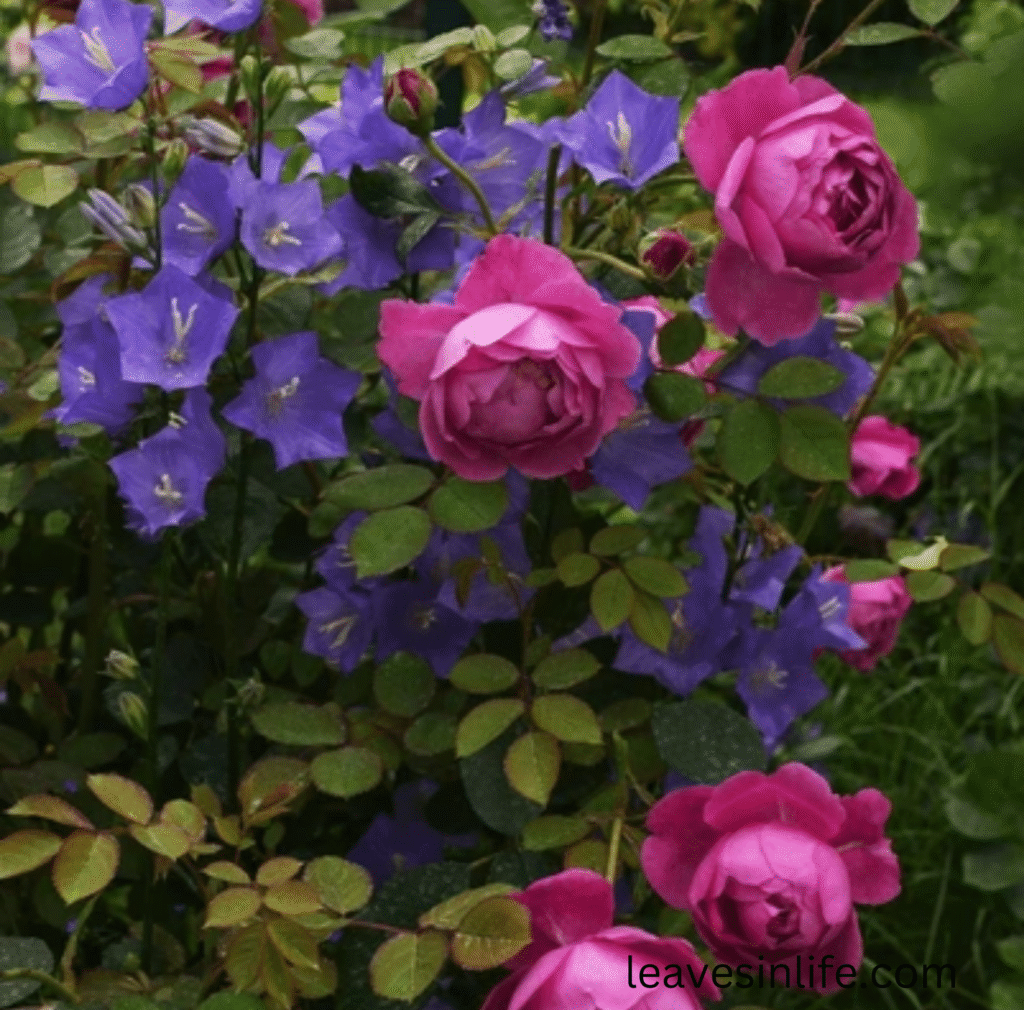
Bellflower (Campanula)
Zones: Bellflowers typically thrive in USDA zones 3–9 and adapt well to sun or partial shade.
Varieties: Upright/Tall Perennials (Campanula persicifolia).Mound-Forming/Compact Perennial (Campanula carpatica).Spreading/Groundcover Perennials (Campanula portenschlagiana).Trailing/Climbing Perennial (Campanula poscharskyana)
Vibe: Cheerful, delicate, timeless, soft, graceful, cottage-garden, romantic.
Height and spread: Bellflowers vary by type: upright varieties grow about 1–3 ft tall and 1–2 ft wide, mound-forming types stay 6–12 in tall and 12–18 in wide, while spreading or trailing forms reach 4–8 in tall and 18–24 in wide.
Blooming period: Upright bellflowers such as Campanula persicifolia bloom in early to mid-summer, mound-forming types like Campanula carpatica flower from late spring to mid-summer, while spreading varieties such as Campanula portenschlagiana can bloom from late spring into early fall.
Bellflowers: Charming Companion Plants for Roses
Adding the right companion plants for roses can enhance both the beauty and health of your rose garden. Bellflowers (Campanula) are one of the best companion plants for roses, offering delicate blooms, lush foliage, and long-lasting color that complements roses perfectly.
Why Bellflowers are Ideal for Roses
Bellflowers provide several benefits when planted alongside roses. Their dense, low-growing foliage helps suppress weeds and retain soil moisture around rose roots. The bell-shaped blooms attract pollinators like bees and butterflies, supporting rose pollination. With their versatile growth habit, bellflowers fill gaps between rose bushes, creating a vibrant and continuous display that enhances the garden’s overall aesthetics. These qualities make bellflowers essential companion plants for roses in any garden design.
Growing Habits of Bellflowers
Bellflowers vary in size depending on the type. Upright varieties such as Campanula persicifolia grow 1–3 ft tall with a spread of 1–2 ft, mound-forming types like Campanula carpatica stay 6–12 in tall and spread 12–18 in, while spreading or trailing forms such as Campanula portenschlagiana reach 4–8 in tall and spread 18–24 in. Bellflowers thrive in full sun to partial shade and adapt well to most garden soils, making them highly compatible with roses.
Best Season to Plant Bellflowers with Roses
The ideal planting time for bellflowers is spring or early fall, allowing roots to establish before extreme summer heat or winter cold. This ensures that bellflowers will bloom alongside your roses, providing complementary color and texture throughout the growing season.
Recommended Bellflower Varieties for Roses
- Campanula persicifolia – upright, blue or white blooms, early to mid-summer
- Campanula carpatica – mound-forming, purple or white blooms, late spring to early summer
- Campanula portenschlagiana – trailing, violet blooms, late spring into summer
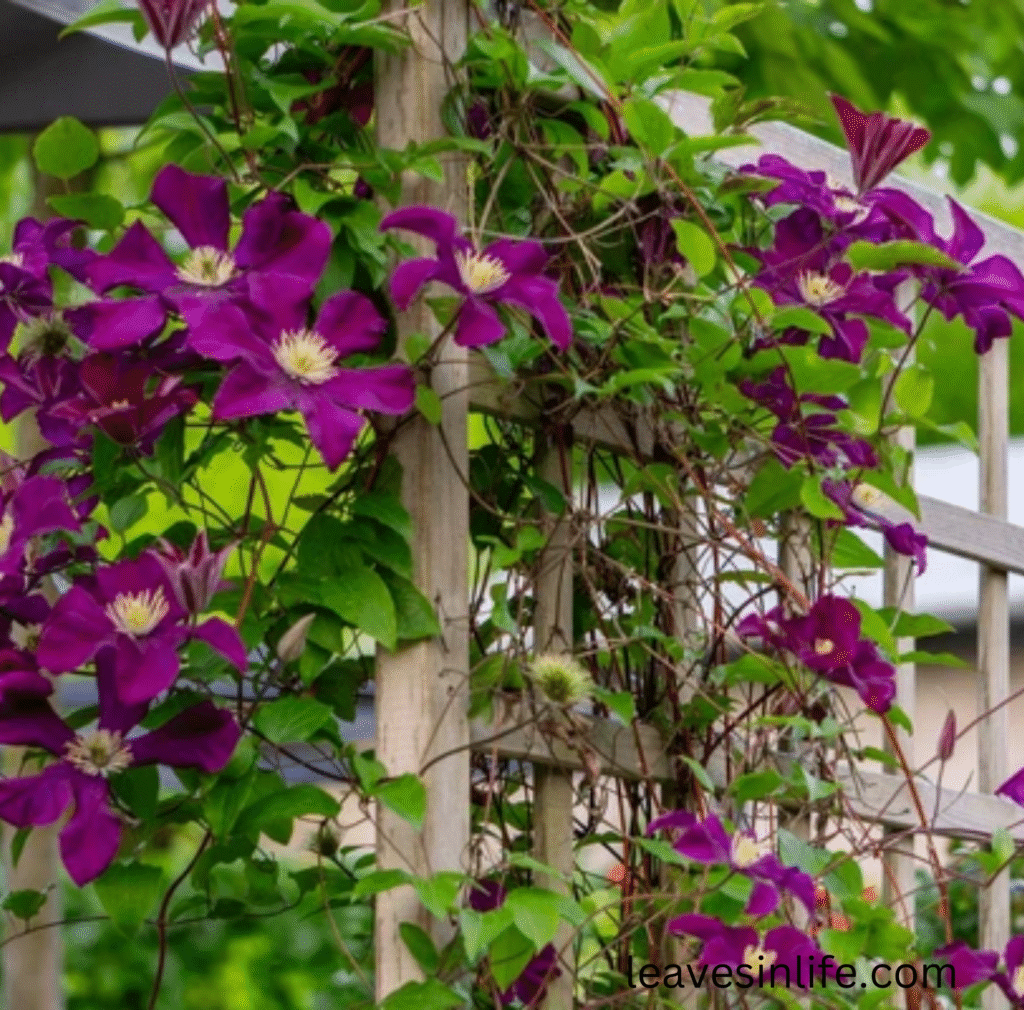
Blooming clematis (armandii)
Zones: Clematis typically blooms well in USDA hardiness zones 4–9, depending on the variety.
Varieties: Early-spring bloomers – (Clematis montana), (Clematis alpina).Late-spring to early-summer bloomers – (Nelly Moser), (The President).Summer to fall bloomers – (Jackmanii), (Sweet Autumn Clematis).
Vibe: Elegant, lush, romantic, graceful, dramatic, enchanting, timeless, vibrant, whimsical, classic.
Height and spread: Blooming clematis varies by group: early types grow about 8–12 ft tall and 3–4 ft wide, large-flowered hybrids reach 6–10 ft tall and 3–4 ft wide, while late-flowering varieties climb 10–20 ft tall and 3–6 ft wide.
Blooming period: Early-flowering clematis such as Clematis montana bloom in spring, large-flowered hybrids like Clematis ‘Nelly Moser’ flower in late spring to early summer (often with a second flush), while late-flowering varieties such as Clematis ‘Jackmanii’ bloom from summer into fall.
Clematis: A Stunning Companion Plants for Roses
Pairing roses with the right companion plants can enhance both their beauty and health. Clematis is one of the most striking companion plants for roses, offering climbing vines, large flowers, and a long blooming season that beautifully complements roses in any garden setting.
Why Clematis is Ideal with Roses
Clematis adds vertical interest and color to rose gardens, making it a favorite among gardeners seeking visual contrast. Its climbing habit allows it to intertwine with rose bushes, providing support and creating layered blooms. The flowers attract pollinators like bees and butterflies, supporting rose pollination, and its foliage helps retain soil moisture and suppress weeds. This makes clematis one of the most effective companion plants for roses.
Growing Habits of Clematis
Clematis varies in size depending on the type. Early-flowering varieties such as Clematis montana grow 8–12 ft tall and spread 3–4 ft wide, large-flowered hybrids like Clematis ‘Nelly Moser’ reach 6–10 ft tall with a 3–4 ft spread, while late-flowering types such as Clematis ‘Jackmanii’ can climb 10–20 ft tall and spread 3–6 ft. Clematis thrives in full sun with cool roots, making it highly compatible with roses.
Best Season to Plant Clematis with Roses
The best time to plant clematis alongside roses is in spring or early fall, allowing roots to establish before extreme summer heat or winter cold. This ensures healthy growth and abundant blooms that complement the roses’ flowering period.
Recommended Clematis Varieties for Roses
- Clematis montana – early spring blooms, vigorous climber
- Clematis ‘Nelly Moser’ – large pale pink blooms, late spring to early summer
- Clematis ‘Jackmanii’ – deep purple flowers, summer into fall
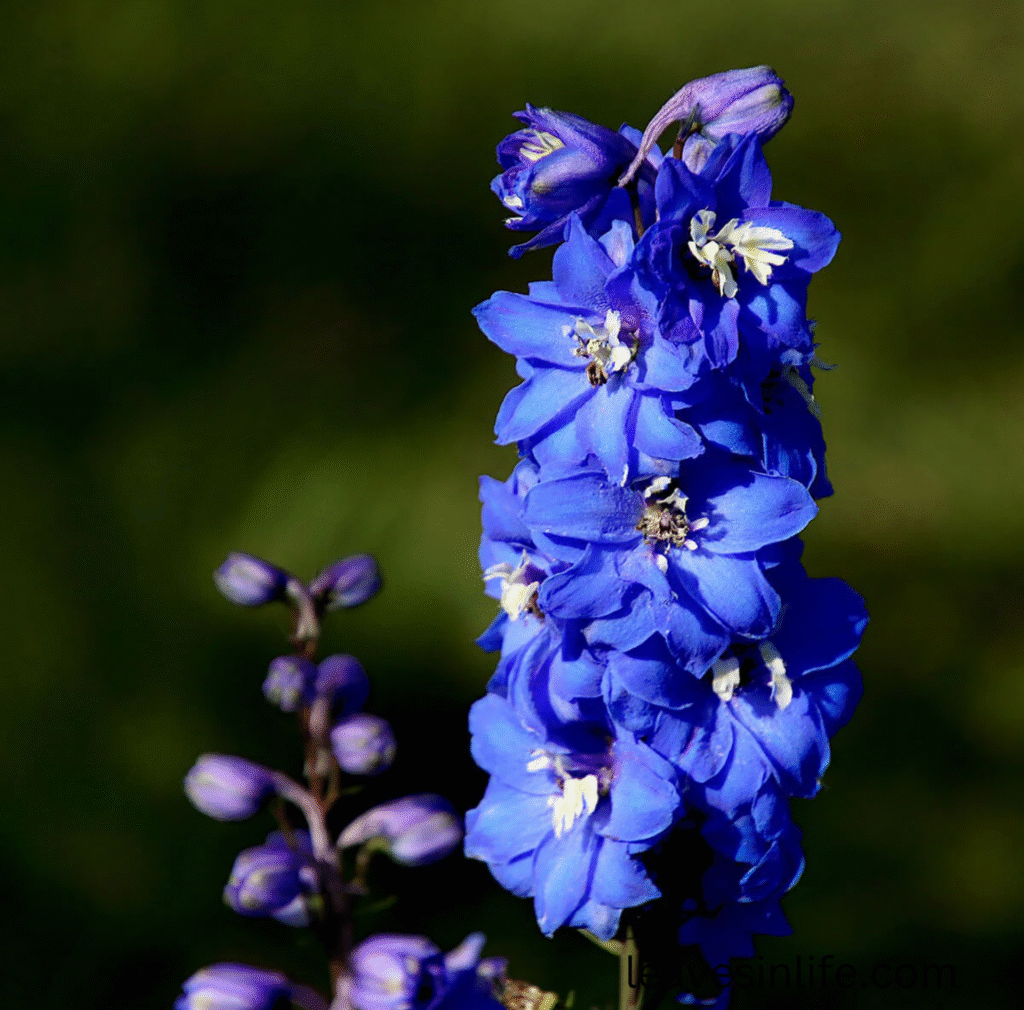
Delphinium (Delphinium elatum)
Zones: Delphiniums typically grow best in USDA hardiness zones 3–7.
Varieties:Tall Perennials (Delphinium elatum), Dwarf/Compact Perennials.Hybrid Perennials ‘Magic Fountains’ series.
Vibe: Bold, majestic, classic, romantic, dramatic, elegant, cottage-garden, vertical, vibrant, graceful.
Height and spread: Delphiniums range by type: tall varieties grow 4–6 ft high and 1–2 ft wide, dwarf types reach 2–3 ft high and 1–1.5 ft wide, while hybrids average 3–5 ft high and 1–2 ft wide.
Blooming period: Tall varieties such as Delphinium elatum bloom in early to mid-summer, compact hybrids like Delphinium ‘Magic Fountains’ flower in early summer, while repeat-blooming types such as Delphinium ‘Pacific Giants’ can produce flowers from early to mid-summer with a possible second flush in late summer.
Delphiniums: Elegant Companion Plants for Roses
Roses look even more stunning when paired with the right companion plants. Delphiniums are one of the most striking companion plants for roses, offering tall, colorful flower spikes that create a dramatic backdrop and enhance the overall garden design.
Why Delphiniums are Ideal for Roses
Delphiniums provide height and structure in rose gardens, making the blooms of roses stand out. Their vertical spikes attract pollinators like bees and butterflies, supporting the overall health and flowering of roses. Delphiniums also help create a layered look in the garden, adding both texture and visual appeal, which makes them one of the top choices among companion plants for roses.
Growing Habits of Delphiniums
Delphiniums vary in size depending on the type. Tall varieties such as Delphinium elatum grow 4–6 ft tall and spread 1–2 ft wide, while compact hybrids like Delphinium ‘Magic Fountains’ reach 2–3 ft tall with a 1–2 ft spread. Repeat-blooming types like Delphinium ‘Pacific Giants’ can produce flowers in early to mid-summer, with a possible second flush in late summer, complementing the rose flowering period. Delphiniums thrive in full sun with well-draining soil, making them highly compatible with roses.
Best Season to Plant Delphiniums with Roses
The ideal planting time for delphiniums is spring or early fall, allowing roots to establish before extreme summer heat or winter cold. This ensures strong growth and abundant flowering that aligns with roses’ bloom cycles.
Recommended Delphinium Varieties for Roses
- Delphinium elatum – tall, classic blue spikes
- Delphinium ‘Magic Fountains’ – compact, vibrant colors
- Delphinium ‘Pacific Giants’ – repeat-blooming, rich hues
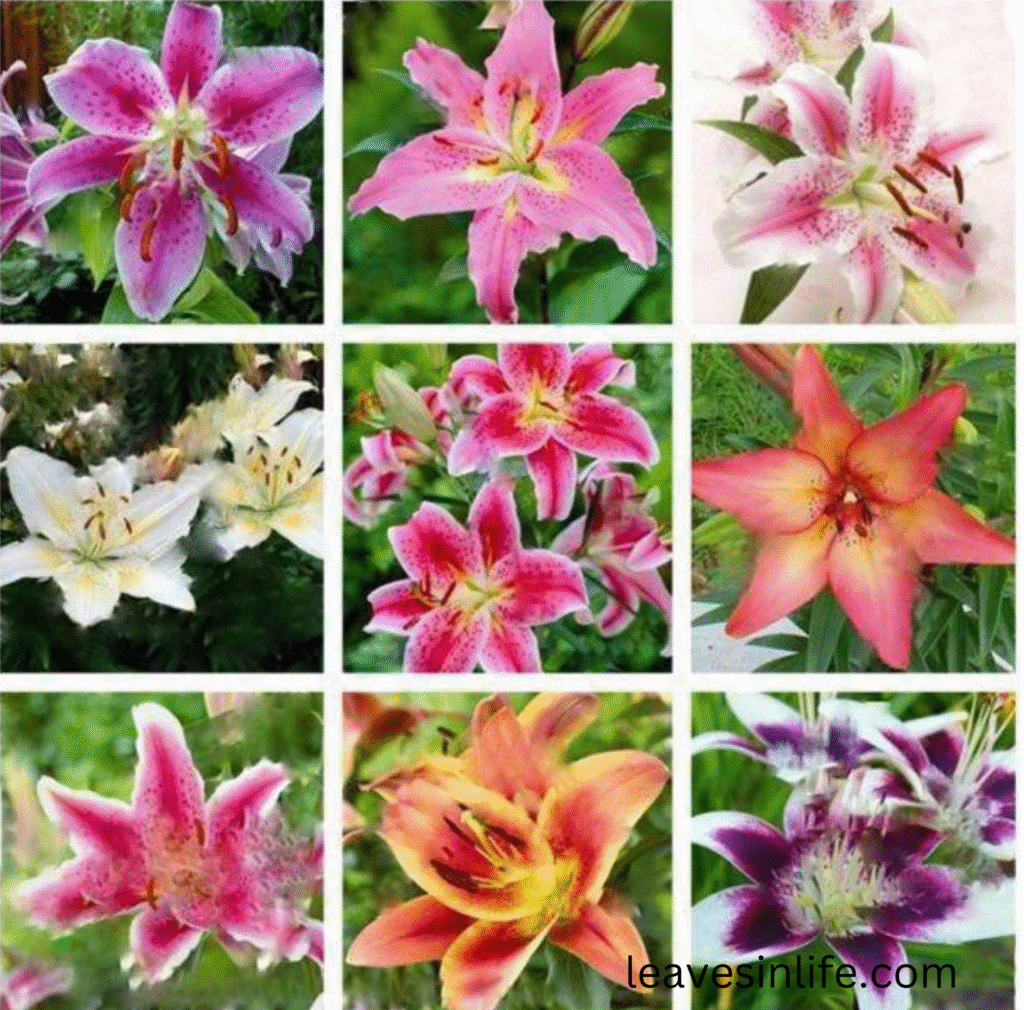
Lily (Lilium)
Zones: Lilies typically grow well in USDA hardiness zones 4–9, depending on the variety.
Varieties: Asiatic Lilies ,Oriental Lilies, Trumpet Lilies, Martagon, LA and OT Hybrids.
Vibe: Elegant, timeless, fragrant, dramatic, luxurious, graceful, classic, vibrant, sophisticated, serene.
Height and spread: Asiatic and LA hybrids usually grow 2–4 ft tall and 1–2 ft wide, Oriental and OT hybrids reach 3–6 ft tall and 1–2 ft wide, while Martagon types often reach 3–5 ft tall and 1–2 ft wide.
Blooming period: Early bloomers such as Asiatic lilies flower in early to mid-summer, mid-season types like Trumpet lilies bloom in mid-summer, while late bloomers such as Oriental lilies produce flowers from mid- to late summer.
Lilies: Vibrant Companion Plants for Roses
Pairing roses with complementary plants enhances both their beauty and garden health. Lilies are ideal companion plants for roses, providing vertical interest, vibrant colors, and long-lasting blooms that harmonize beautifully with rose flowers.
Why Lilies are Ideal for Roses
Lilies bring height, texture, and rich colors to rose gardens. Their upright stems create a striking contrast to the rounded form of rose bushes, while their flowers attract pollinators like bees and butterflies, supporting rose health and flowering. This makes lilies one of the most effective companion plants for roses for both visual appeal and ecosystem support.
Growing Habits of Lilies
Lilies vary in size depending on the type. Early-blooming Asiatic lilies grow 2–3 ft tall with a spread of 1–2 ft, mid-season Trumpet lilies reach 3–4 ft tall and 1–2 ft wide, while late-blooming Oriental lilies grow 3–5 ft tall with a spread of 1–2 ft. Lilies thrive in full sun to partial shade and well-draining soil, making them highly compatible with roses.
Best Season to Plant Lilies with Roses
The best time to plant lilies is spring or early fall, allowing bulbs to establish roots before extreme summer heat or winter cold. This timing ensures that lilies bloom alongside roses, creating a harmonious and continuous display of color.
Recommended Lily Varieties for Roses
- Asiatic lilies – early summer blooms, vibrant colors
- Trumpet lilies – mid-summer blooms, fragrant flowers
- Oriental lilies – late summer blooms, large and fragrant flowers
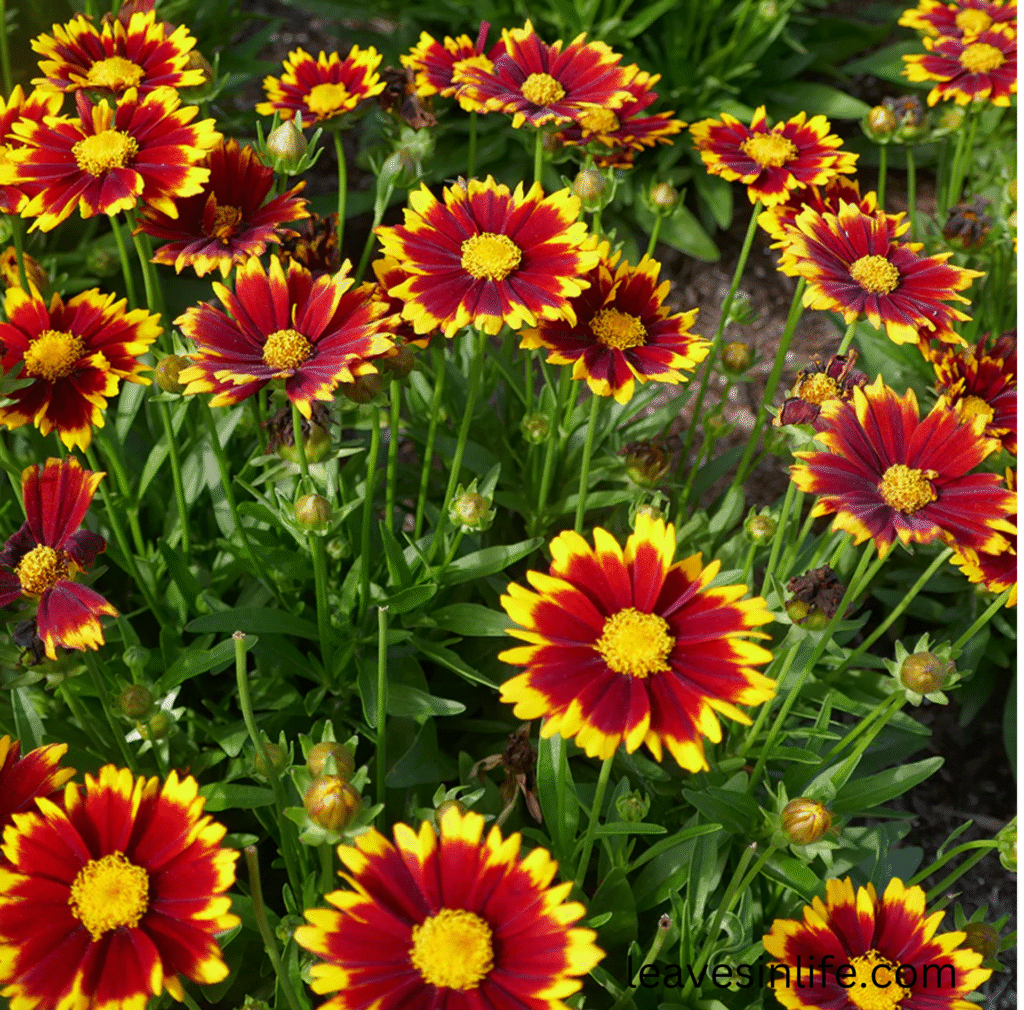
tickseed (Coreopsis spp.)
Zones: Tickseeds (Coreopsis) typically thrive in USDA hardiness zones 4–9, depending on the species and growing conditions.
Varieties: Tall Perennials – (Coreopsis tripteris) Compact/Low-Growing Perennials– (Coreopsis verticillata),Hybrid Varieties.
Vibe: Cheerful, bright, carefree, sunny, playful, light, charming, natural, easygoing, vibrant.
Height and spread: Tickseeds (Coreopsis) generally grow 1–3 ft tall and 1–2 ft wide, with dwarf varieties around 8–12 in tall and 12–18 in wide, while taller meadow types can reach up to 4 ft tall and 2 ft wide.
blooming period: Early-blooming types such as Coreopsis grandiflora flower in late spring to early summer, mid-season varieties like Coreopsis verticillata bloom in early to mid-summer, while long-blooming hybrids such as Coreopsis ‘Moonbeam’ can produce flowers from late spring into fall.
Tickseeds: Cheerful Companion Plants for Roses
Adding the right companion plants can enhance both the health and appearance of roses. Tickseeds (Coreopsis) are ideal companion plants for roses, offering bright, long-lasting blooms that complement roses’ colors and provide continuous interest throughout the garden.
Why Tickseeds are Ideal for Roses
Tickseeds are low-maintenance perennials that thrive alongside roses. Their cheerful daisy-like flowers attract pollinators like bees and butterflies, improving the overall health and flowering of roses. Their mounding habit helps cover bare soil, suppress weeds, and retain moisture, making tickseeds one of the best companion plants for roses for both aesthetics and garden functionality.
Growing Habits of Tickseeds
Tickseeds vary in size depending on the variety. Early-blooming types such as Coreopsis grandiflora grow 12–24 in tall and spread 12–18 in wide, mid-season types like Coreopsis verticillata reach 18–24 in tall and 12–18 in wide, while long-blooming cultivars such as Coreopsis ‘Moonbeam’ can grow 24–36 in tall and spread 12–24 in wide. Tickseeds thrive in full sun with well-draining soil, perfectly matching rose growing conditions.
Best Season to Plant Tickseeds with Roses
The ideal time to plant tickseeds is spring or early fall, allowing roots to establish before extreme summer heat or winter cold. This ensures vibrant blooms that complement roses during their peak flowering season.
Recommended Tickseed Varieties for Roses
- Coreopsis grandiflora – early bloom, bright yellow flowers
- Coreopsis verticillata – mid-season, fine-textured foliage and yellow blooms
- Coreopsis ‘Moonbeam’ – long-blooming, pale yellow flowers
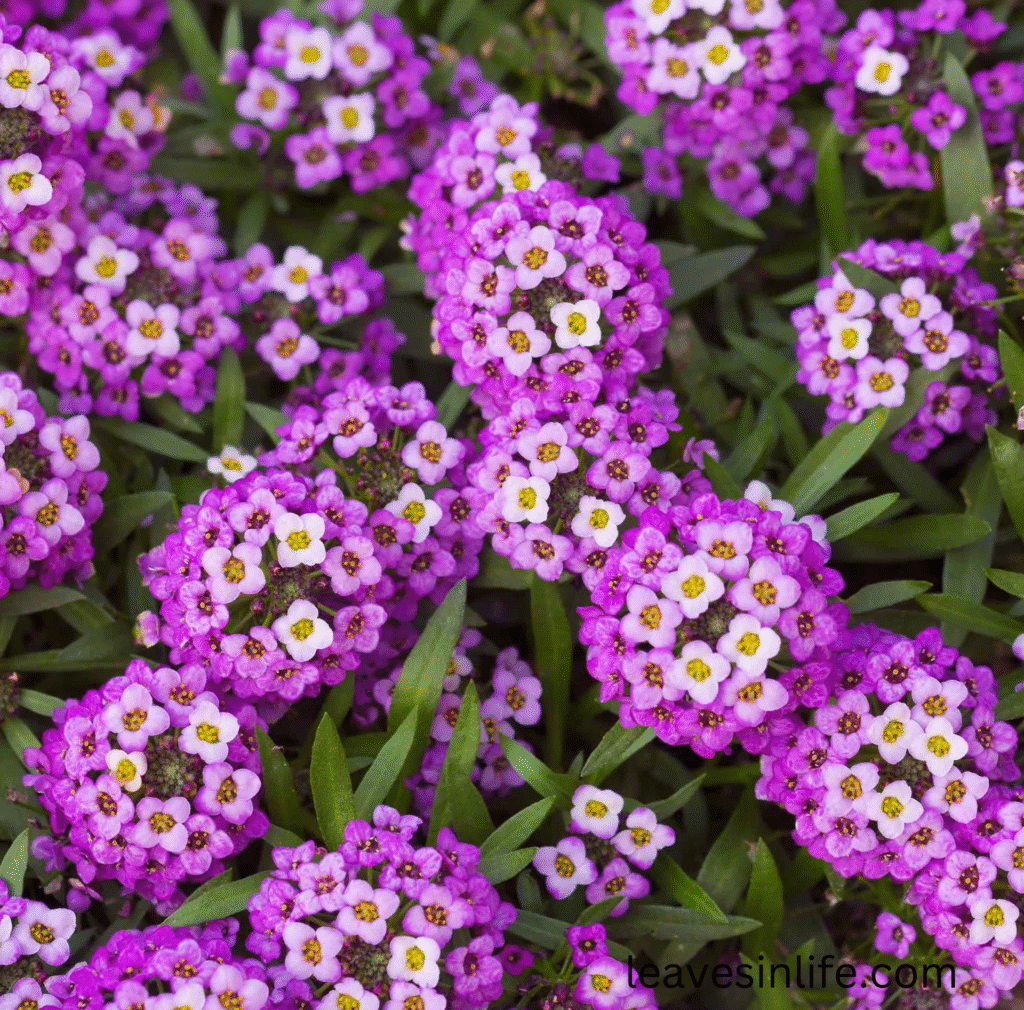
Alyssum (Lobularia maritima)
Zones:Alyssum (Lobularia maritima) typically grows well in USDA hardiness zones 5–9 and is often grown as an annual in cooler zones.
Varieties: Trailing/Spreading Varieties –(Snow Princess), Upright/Compact Varieties – (Royal Carpet), Hybrid or Fragrant Varieties.
Vibe: Sweet, delicate, soft, fragrant, charming, gentle, airy, soothing, light, inviting.
Height and spread: Alyssum (Lobularia maritima) generally grows 3–6 in tall and 6–12 in wide, with trailing varieties spreading up to 24 in while staying low and compact.
Blooming period: Early-blooming varieties such as Alyssum ‘Royal Carpet’ flower in spring, mid-season types like Alyssum ‘Easter Bonnet’ bloom in spring to early summer, while long-blooming cultivars such as Alyssum ‘Snow Princess’ can produce flowers from spring into fall.
Alyssum: Fragrant Companion Plants for Roses
Pairing roses with complementary plants can enhance both beauty and garden health. Alyssum (Lobularia maritima) is one of the best companion plants for roses, offering fragrant, low-growing blooms that create a delicate carpet around rose bushes.
Why Alyssum is Ideal for Roses
Alyssum provides several benefits when planted alongside roses. Its dense, low-growing foliage helps suppress weeds, retain soil moisture, and protect rose roots. The sweet fragrance and abundant flowers attract pollinators like bees and butterflies, supporting rose pollination. These qualities make alyssum an excellent choice among companion plants for roses.
Growing Habits of Alyssum
Alyssum typically grows 4–8 in tall with a spread of 12–18 in, depending on the variety. It thrives in full sun to partial shade and adapts well to most garden soils. Low-maintenance and fast-growing, alyssum fills gaps around rose bushes, creating a continuous bloom carpet throughout the season.
Best Season to Plant Alyssum with Roses
The best time to plant alyssum is spring or early fall, giving roots time to establish before extreme heat or cold. This ensures vibrant blooms that complement roses during their peak flowering season.
Recommended Alyssum Varieties for Roses
- Alyssum ‘Royal Carpet’ – early spring bloom, dense white flowers
- Alyssum ‘Easter Bonnet’ – spring to early summer, colorful pastel blooms
- Alyssum ‘Snow Princess’ – long-blooming, pure white flowers
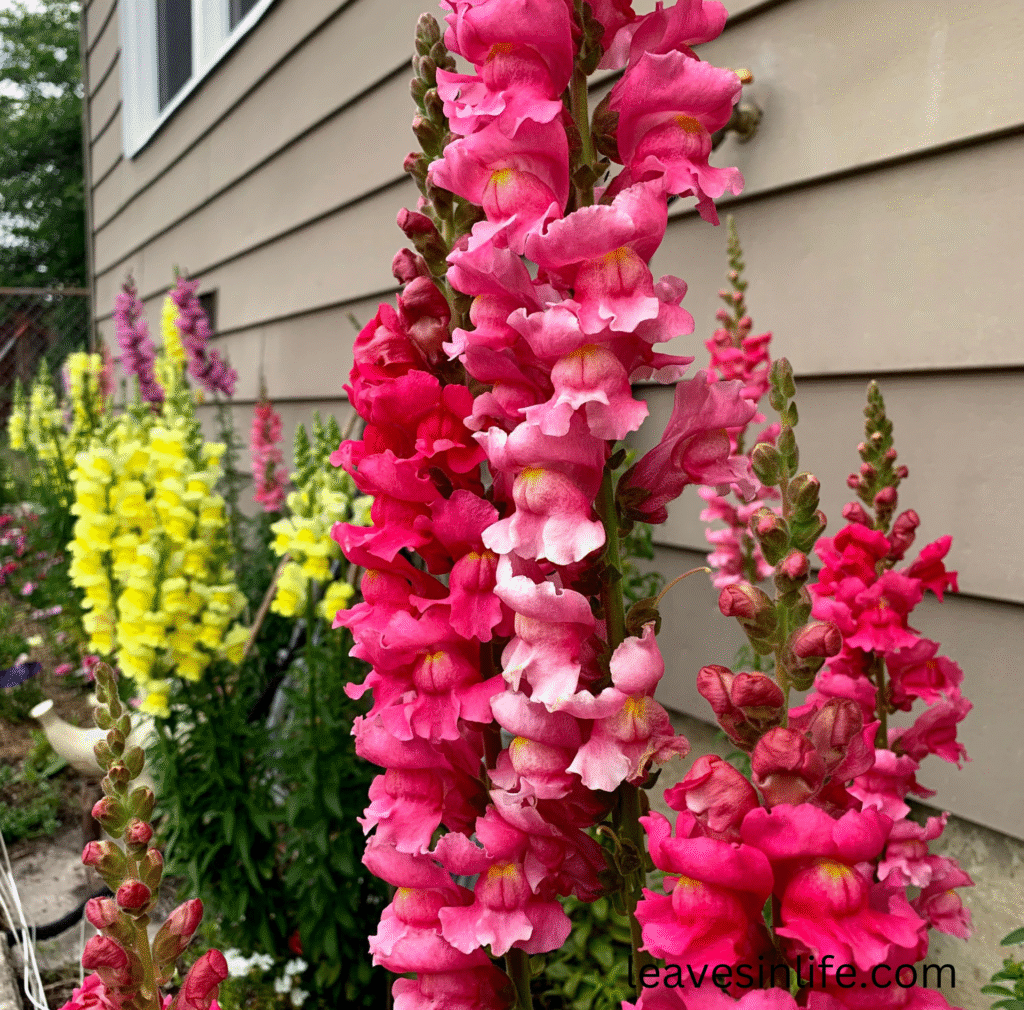
Snapdragons (Antirrhinum)
Zones: Snapdragons (Antirrhinum) typically grow well in USDA hardiness zones 7–10 as perennials, and are often treated as annuals in cooler zones.
Varieties: Tall Varieties: (Rocket Mix), (Black Prince), Dwarf/Compact Varieties: (Sonnet Mix), (Little Beauty), Hybrid Varieties: (Madame Butterfly), (Liberty Classic).
Vibes: Playful, colorful, cheerful, whimsical, lively, charming, classic, nostalgic, vibrant, fun.
Height and spread: dwarf varieties grow 6–12 in tall and 6–9 in wide, mid-sized types reach 12–24 in tall and 9–12 in wide, while tall varieties can grow 24–36 in tall and 12–18 in wide.
Blooming period: Early-blooming varieties such as Snapdragon ‘Sonnet’ flower in spring to early summer, mid-season types like Snapdragon ‘Rocket’ bloom in early to mid-summer, while long-blooming hybrids such as Snapdragon ‘Madame Butterfly’ can produce flowers from spring into fall.
Snapdragons: Colourful Companion Plants for Roses
Enhancing your rose garden with the right companions can improve both aesthetics and plant health. Snapdragons (Antirrhinum majus) are excellent companion plants for roses, providing vertical color, long-lasting blooms, and a charming contrast to rose flowers.
Why Snapdragons are Ideal for Roses
Snapdragons add height and texture to rose beds, creating layers that make rose blooms stand out. Their tubular flowers attract pollinators like bees and butterflies, supporting rose pollination. With their vibrant colors and upright growth habit, snapdragons are a reliable choice among companion plants for roses for both beauty and functionality.
Growing Habits of Snapdragons
Snapdragons vary in size depending on the type. Dwarf varieties grow 6–12 in tall and 6–9 in wide, mid-sized types reach 12–24 in tall and 9–12 in wide, while tall varieties can grow 24–36 in tall and 12–18 in wide. Snapdragons thrive in full sun with well-draining soil, making them highly compatible with roses.
Best Season to Plant Snapdragons with Roses
The ideal time to plant snapdragons is spring or early fall, allowing roots to establish before extreme heat or frost. This ensures that their blooms complement roses during peak flowering seasons. these are the best companion plants for roses
Recommended Snapdragon Varieties for Roses
these varieties are highly recommended as companion plants for roses
- Antirrhinum majus ‘Rocket Mix’ – tall, vibrant multicolor blooms
- Antirrhinum majus ‘Sonnet’ – compact, pastel colors
- Antirrhinum majus ‘Liberty’ – tall, rich-colored spikes
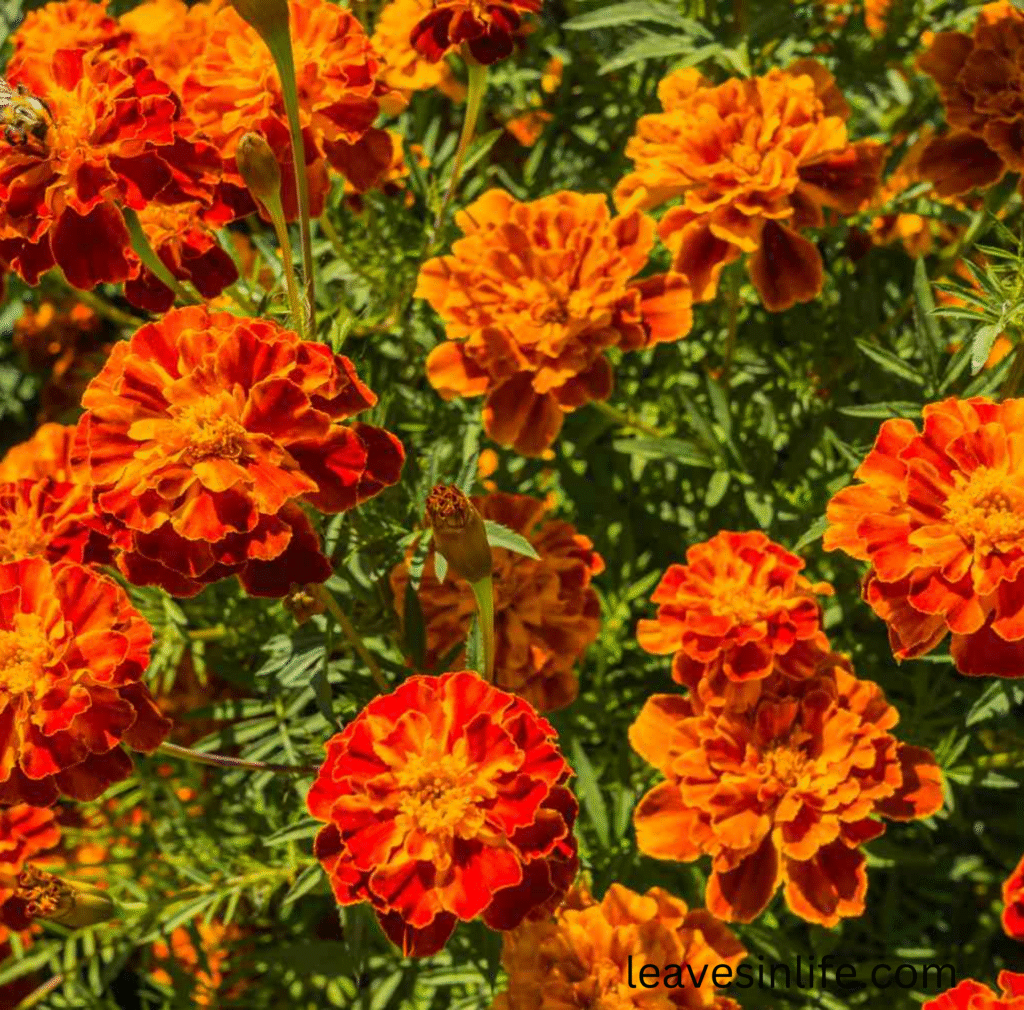
Marigolds (Tagetes)
Zones: Marigolds (Tagetes) typically grow well in USDA hardiness zones 2–11 as annuals, thriving in full sun and well-drained soil.
Varieties: Tall Varieties: (Crackerjack), (Inca II), Dwarf/Compact Varieties: (Bonanza), (Lemon Gem), Hybrid Varieties: (Signet), (Taishan).
Vibe: Bright, bold, cheerful, sunny, festive, warm, lively, traditional, vibrant, welcoming.
Height and spread: Marigolds vary by type: dwarf varieties grow 6–12 in tall and 6–9 in wide, mid-sized types reach 12–18 in tall and 9–12 in wide, while tall African marigolds can grow 18–36 in tall and 12–18 in wide.
Blooming period: Early-blooming varieties such as Tagetes tenuifolia flower in late spring to early summer, mid-season types like Tagetes patula bloom in summer, while long-blooming African marigolds such as Tagetes erecta can produce flowers from late spring into fall.
Marigolds: Bright Companion Plants for Roses
Adding the right companion plants can improve the health and beauty of your rose garden. Marigolds (Tagetes) are excellent companion plants for roses, offering bright, cheerful blooms that deter pests and create a vibrant contrast to rose flowers.
Why Marigolds are Ideal for Roses
Marigolds are known for their pest-repellent properties, helping to protect roses from nematodes and certain insects. Their dense, bushy growth also helps suppress weeds and maintain soil moisture. Additionally, their flowers attract pollinators like bees and butterflies, enhancing rose pollination. These qualities make marigolds one of the most effective companion plants for roses.
Growing Habits of Marigolds
Marigolds vary in size depending on the variety. Dwarf varieties grow 6–12 in tall and 6–12 in wide, medium types reach 12–24 in tall and 12–18 in wide, while tall varieties can grow 24–36 in tall and 18–24 in wide. Marigolds thrive in full sun with well-draining soil, making them perfectly compatible with roses.
Best Season to Plant Marigolds with Roses
The ideal time to plant marigolds is spring or early summer, allowing them to establish roots and bloom alongside roses during peak flowering periods. Their long flowering season ensures continuous color and protection for your rose beds.
Recommended Marigold Varieties for Roses
Following varieties of marigold are recommended as best companion plants for roses
- Tagetes erecta ‘African Marigold’ – tall, bright orange blooms
- Tagetes patula ‘French Marigold’ – compact, multi-colored flowers
- Tagetes tenuifolia ‘Signet Marigold’ – small, golden blooms, edible petals
Best Annual Companion Plants for Roses: Boost Colour, Health & Pollinators

| PANSIES/VIOLAS (Violaceae) | Bright, cheerful, charming vibe, Compact, low-growing, mounding plants, Soft, rounded foliage, Mild, sweet floral scent, Cold-tolerant seasonal color, Pollinator-friendly, garden-brightening blooms |
| COSMOS (Cosmos bipinnatus) | Airy, carefree, sunny vibe, Tall, graceful, branching plants, Fine, feathery foliage, Light, subtle floral scent,Heat- and drought-tolerant, Pollinator-friendly, long-blooming flowers |
| ZINNIAS (Zinnia elegans) | Bold, cheerful, summer-bright vibe, Upright, medium to tall plants, Simple, lush green foliage, Fresh, lightly earthy scent, Heat-loving, long-lasting blooms, Pollinator-friendly, butterfly-attracting flowers |
| PETUNIAS (Petunia ×atkinsiana) | Bright, lively, colorful vibe, Trailing to mounding plants, Soft, slightly sticky foliage, Sweet, pleasant floral scent, Heat-tolerant, Best companion plants for roses continuous blooms, Pollinator-friendly, easy-care flowers |
| VERBENA (Verbena aristigera) | Sunny, vibrant, cheerful vibe, Low-growing, spreading plants, Fine-textured, soft foliage, Light, delicate floral scent, Heat- and drought-tolerant, Beneficial companion plants for roses, Pollinator-friendly, long-season blooms |
| MILLION BELLS (calibracoa) | Bright, playful, cascading vibe, Compact, trailing plants, Small, neat green foliage, Soft, sweet floral hint, Heat-tolerant, nonstop blooming, Pollinator-friendly, container-perfect flowers, highly recommended companion plants for roses |
| SUMMER SNAPDRAGON (Angelonia angustifolia) | Fresh, upright, summery vibe, Medium to tall, spiky plants, Narrow, glossy green foliage, Light, fruity-floral scent, Heat-loving, long-lasting blooms Pollinator-friendly, low-maintenance flowers |
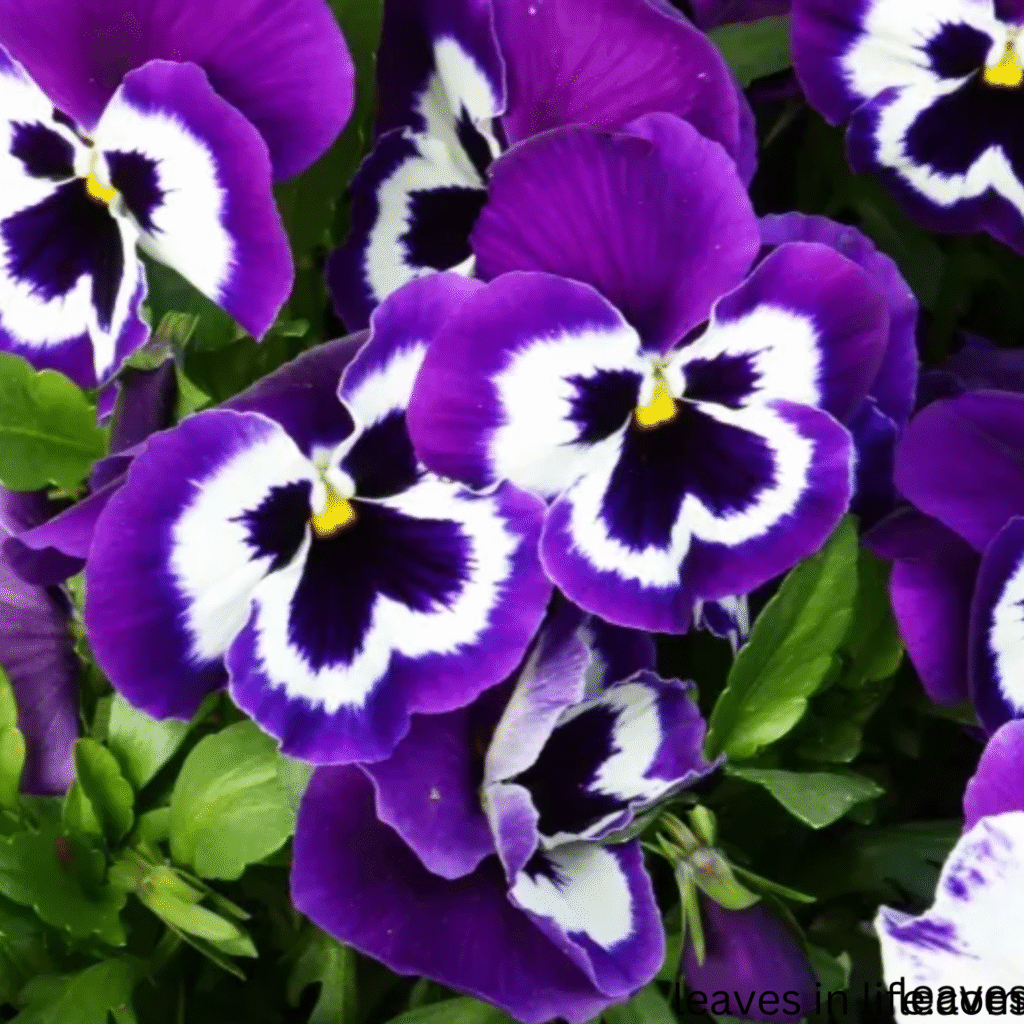
PANSIES/VIOLAS (Violaceae)
Zones: Violas grow best in USDA Zones 3–9, thriving in cool seasons and fading in summer heat.
Vibe: Delicate, charming, playful, graceful, cool-toned, romantic, gentle, timeless, uplifting, elegant.
Varieties: Pansies come in four broad types: Large-Flowered — Majestic Giant, Swiss Giant; Multiflora — Crystal Bowl, Maxim; Trailing/Spreading — Cool Wave, Freefall; Specialty/Unique — Black Beauty, Joker Series.
Height and spread: Large-Flowered — 8–12 in tall and 8–12 in wide; Multiflora — 6–9 in tall and 8–10 in wide; Trailing/Spreading — 6–8 in tall and 12–24 in wide; Specialty/Unique — 6–9 in tall and 8–10 in wide.
Blooming period:Large-Flowered — Spring to early summer and again in fall in cooler climates; Multiflora — Early spring through late spring, often blooming longer into summer; Trailing/Spreading — Spring through fall with consistent color in mild weather; Specialty/Unique — Spring to early summer and fall, timing varies slightly with each unique type.
Brighten Your Rose Garden with Pansies: Perfect Companion Plants for Roses
Pansies are vibrant, hardy annuals adding cheerful colour and charm to rose gardens. Their delicate blooms complement the elegance of roses, creating a layered and inviting flower display. Planting pansies with roses enhances aesthetics, attracts pollinators, and encourages a healthy, thriving garden ecosystem.
Why Are Pansies Ideal Plants for Roses?
Pansies are perfect companion plants for roses because they are low-growing, cool-season annuals that help shade soil and retain moisture for rose roots. Their colourful flowers — ranging from deep purples and bright yellows to soft pastels — contrast beautifully with rose petals. Pansies are also generally pest-resistant, allowing them to coexist with roses without competing for nutrients.
Growing Habits of Pansies
These charming annuals typically grow 6–12 inches tall and spread 6–12 inches wide, depending on the variety. Pansies thrive in well-drained soil with moderate moisture and prefer full sun to partial shade, making them easy companions for roses. Their continuous blooms in cool weather provide steady color throughout spring and fall.
Best Season to Plant Pansies with Roses
The ideal time to plant pansies is early spring or fall, when temperatures are cooler. Planting during these periods ensures healthy growth, long-lasting blooms, and a vibrant display that complements roses at their peak.
Top Pansy Varieties to Plant with Roses
- Majestic Giant
- Swiss Giant
- Crystal Bowl
- Cool Wave
- Black Beauty
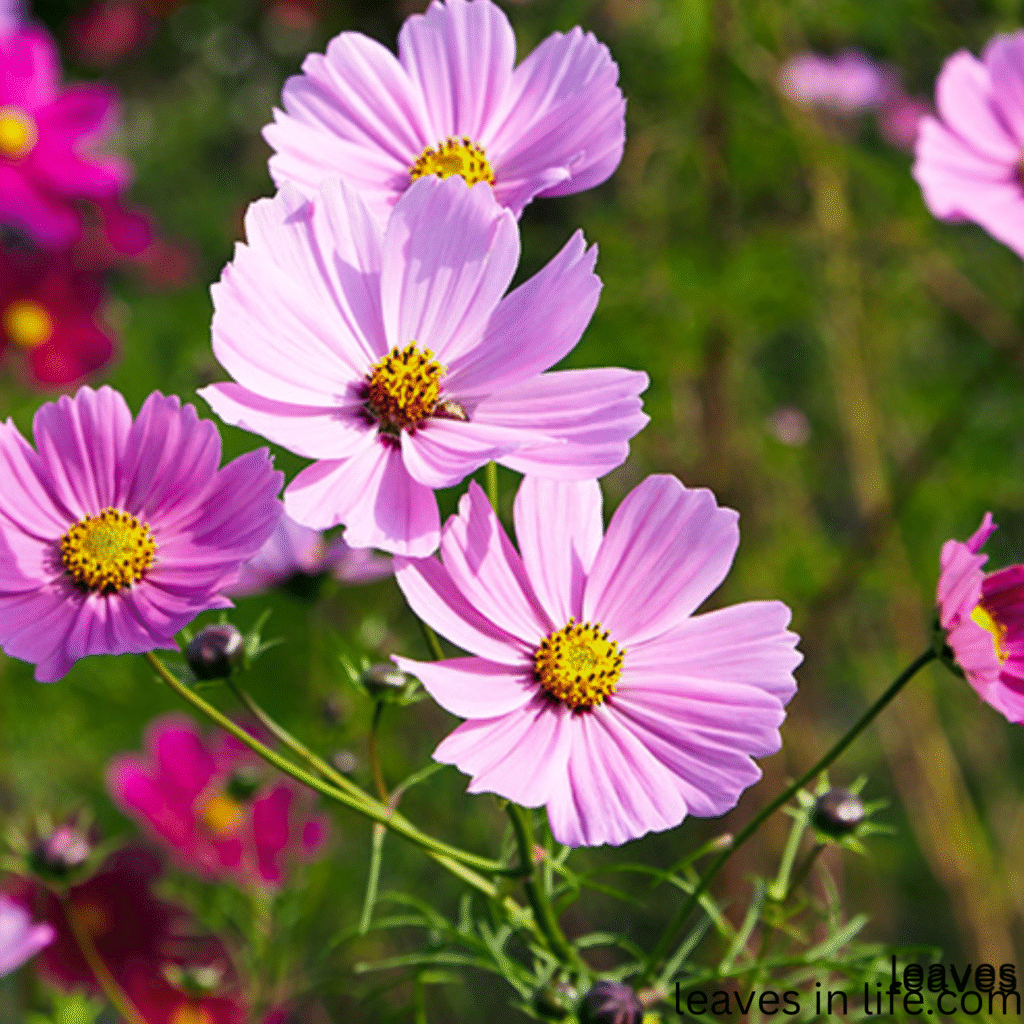
COSMOS (Cosmos bipinnatus)
Zones: Cosmos grow best in USDA Zones 2–11, thriving in warm weather and full sun.
Vibe: Airy, whimsical, carefree, lighthearted, graceful, sunny, bohemian, joyful, effortless, radiant.
Varieties: Tall Varieties — Sensation, Versailles; Dwarf/Compact Varieties — Sonata, Cosmic; Double/Frilled Varieties — Double Click, Sea Shells; Specialty/Unique Varieties — Xanthos, Cupcakes.
Height and spread: Tall Varieties — 36–60 in tall and 24–36 in wide; Mid-Sized Varieties — 18–36 in tall and 18–24 in wide; Dwarf/Compact Varieties — 12–18 in tall and 12–18 in wide; Specialty/Unique Varieties — 24–40 in tall and 18–24 in wide.
Blooming period: Tall varieties bloom from summer through fall. Mid-sized varieties flower from early summer into fall. Dwarf or compact varieties bloom from late spring through late summer. Specialty or unique varieties flower from summer until frost.
Add Height and Charm: Cosmos as Companion Plants for Roses
Cosmos are elegant, airy annuals that make excellent companion plants for roses, adding vertical interest and a whimsical charm to rose gardens. Their delicate, daisy-like blooms contrast beautifully with roses, creating a dynamic and eye-catching flower display. Planting cosmos with roses enhances garden aesthetics, attracts pollinators, and supports a healthy garden ecosystem, making them a versatile and practical choice for any rose bed.
Why Are Cosmos Ideal to Plants with Roses?
Cosmos are tall, upright growth and airy foliage, which provide a light, textured backdrop for rose blooms. Their long-lasting flowers in shades of pink, white, and deep magenta complement roses without overshadowing them. Cosmos are also low-maintenance and drought-tolerant, allowing them to thrive alongside roses without competing for nutrients.
Growing Habits of Cosmos
Tall varieties grow 36–60 inches tall with a spread of 24–36 inches, while mid-sized types reach 18–36 inches tall and 18–24 inches wide. Dwarf or compact varieties stay 12–18 inches tall and 12–18 inches wide, and specialty varieties can grow 24–40 inches tall with 18–24 inches wide spread. Cosmos thrive in well-drained soil with full sun and produce abundant blooms throughout the growing season, adding consistent color to rose gardens.
Best Season to Plant Cosmos with Roses
The best time to plant cosmos is late spring to early summer, after the danger of frost has passed. Planting during this time ensures vigorous growth and continuous blooms that complement roses throughout summer and into fall.
Top Cosmos Varieties to Plant with Roses
Following varieties of cosmos are the best companion plants for roses:
- Sensation
- Versailles
- Sonata
- Cosmic
- Cupcakes

ZINNIAS (Zinnia elegans)
Zones: Zinnias thrive in USDA Hardiness Zones 3 through 10, flourishing in warm, sunny conditions (versatile across many varieties).
Vibe: Bold, vibrant, cheerful, energetic, festive, playful, sunny, lively, colorful, uplifting.
Varieties: Tall Varieties — Benary’s Giant, State Fair; Dwarf/Compact Varieties — Profusion, Thumbelina; Double/Frilled Varieties — Queen Lime, Candy Cane; Specialty/Unique Varieties — Persian Carpet, Zinderella.
Height and spread: Tall Varieties — 24–48 in tall and 18–24 in wide; Mid-Sized Varieties — 12–24 in tall and 12–18 in wide; Dwarf/Compact Varieties — 6–12 in tall and 6–12 in wide; Specialty/Unique Varieties — 12–30 in tall and 12–18 in wide.
Blooming period: Tall varieties bloom from summer until frost. Mid-sized varieties flower from early summer through fall. Dwarf or compact varieties bloom from late spring through late summer. Specialty or unique varieties flower from summer until frost.
Add Vibrant Colour with Zinnias: Perfect Companion Plants for Roses
Zinnias are bright, bold annuals that make excellent companion plants for roses, adding vibrant color and texture to rose gardens. Their cheerful blooms contrast beautifully with roses, creating a lively and eye-catching display. Planting zinnias not only enhances garden aesthetics but also attracts pollinators, supports beneficial insects, and promotes a healthy garden ecosystem, making them a practical and visually appealing companion plants for roses.
Why Are Zinnias Ideal to Plants with Roses?
Zinniasare low-maintenance, heat-tolerant, and long-blooming, thriving alongside roses without competing for nutrients. Their bold, colorful flowers in shades of red, pink, orange, yellow, and white complement rose blooms perfectly, creating continuous seasonal interest. Zinnias also deter pests naturally and fill gaps between roses, enhancing the overall beauty and health of the rose garden.
Growing Habits of Zinnias
Tall varieties grow 24–48 inches tall and 18–24 inches wide, mid-sized types reach 12–24 inches tall and 12–18 inches wide, while dwarf or compact varieties grow 6–12 inches tall and 6–12 inches wide. Speciality or unique varieties can reach 12–30 inches tall with 12–18 inches wide spread. Zinnias thrive in well-drained soil with full sun and provide abundant blooms throughout summer until frost, making them consistent and colourful .
Best Season to Plant Zinnias with Roses
The best time to plant zinnias is late spring after frost, ensuring vigorous growth and a long-lasting bloom season that perfectly complements roses during summer and fall.
Top Zinnia Varieties to Plant with Roses
Following varieties of zinnias are best companion plants for roses
- Benary’s Giant
- State Fair
- Profusion
- Thumbelina
- Persian Carpet
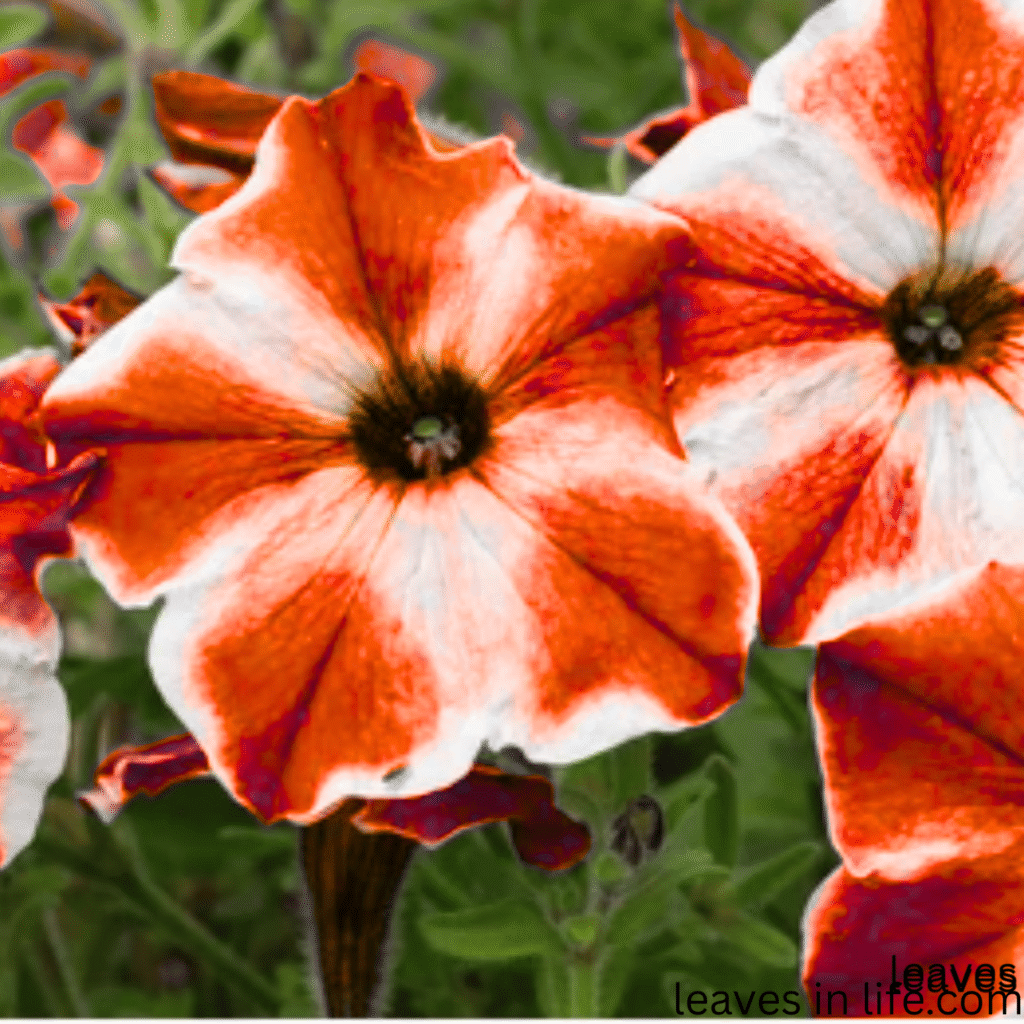
PETUNIAS (Petunia ×atkinsiana)
Zones: Petunias thrive in USDA Hardiness Zones 9 through 11, typically grown as annuals in cooler zones (versatile across many varieties).
Vibe: Soft, romantic, vibrant, versatile, welcoming, graceful, cheerful, lush, classic, charming.
Varieties: Grandiflora Varieties — Daddy Series, Dream Series; Multiflora Varieties — Celebrity, Carpet Series; Milliflora Varieties — Fantasy, Picobella; Trailing/Spreading Varieties — Wave Series, Surfinia.
height and spread: Grandiflora Varieties — 8–12 in tall and 10–14 in wide; Multiflora Varieties — 8–12 in tall and 10–14 in wide; Milliflora Varieties — 6–8 in tall and 8–10 in wide; Trailing/Spreading Varieties — 6–12 in tall and 18–30 in wide.
Blooming period: Grandiflora varieties bloom from spring through fall. Multiflora varieties flower from spring through late summer. Milliflora varieties bloom from late spring through fall. Trailing/spreading varieties flower from spring until frost.
Lush and Colorful: Petunias as Companion Plants for Roses
Petunias are versatile, vibrant annuals that make excellent companion plants for roses, adding lush colour and texture to rose gardens. Their cascading blooms complement the elegance of roses, creating a dynamic and eye-catching display. Planting petunias as companion plants for roses not only enhances visual appeal but also attracts pollinators, supports beneficial insects, and encourages a thriving garden ecosystem, making them an ideal choice for any rose bed.
Why Are Petunias Ideal to Plants with Roses?
Petunias are perfect companion plants for roses because they are low-maintenance, long-blooming, and adaptable to various soil conditions. Their vibrant flowers in shades of pink, purple, white, and red contrast beautifully with rose petals while trailing varieties can fill gaps or cascade from edges, adding dimension and fullness to rose beds. Petunias are also pest-resistant and heat-tolerant, allowing them to grow effortlessly alongside roses without competing for nutrients.
Growing Habits of Petunias
Grandiflora varieties grow 8–12 inches tall and 10–14 inches wide, Multiflora varieties reach 8–12 inches tall and 10–14 inches wide, Milliflora types grow 6–8 inches tall and 8–10 inches wide, and Trailing/Spreading varieties can reach 6–12 inches tall with a spread of 18–30 inches. Petunias thrive in well-drained soil with full sun and provide continuous blooms throughout spring, summer, and fall, making them reliable companions.
Best Season to Plant Petunias with Roses
The optimal time to plant petunias is spring after frost, ensuring vigorous growth, long-lasting blooms, and a vibrant display that enhances roses during their peak flowering period.
Top Petunia Varieties to Plant with Roses
Following varieties of petunia are best companion plants for roses:
- Daddy Series
- Dream Series
- Celebrity
- Carpet Series
- Wave Series
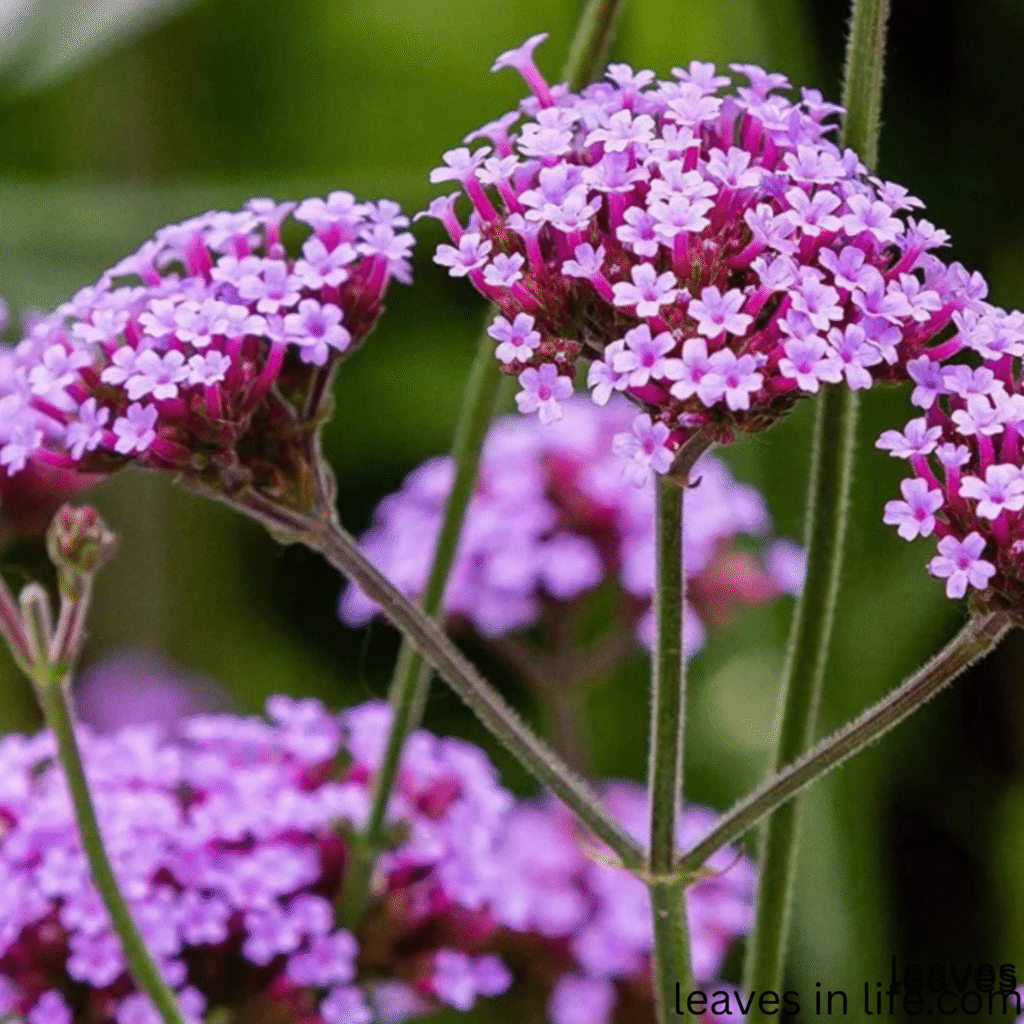
VERBENA (Verbena aristigera)
Zones: Verbena thrives in USDA Hardiness Zones 7 through 11, often grown as annuals in cooler zones (versatile across many varieties).
Vibe: Bright, lively, carefree, cheerful, trailing, festive, colourful, playful, sunny, uplifting.
Varieties: Upright Varieties — Quartz, Obsession; Trailing Varieties — Tapien, Lanai; Moss/Low-Growing Varieties — Moss Verbena, Homestead Purple; Hybrid Varieties — Endurascape, Superbena.
height and spread: Upright Varieties — 8–12 in tall and 10–12 in wide; Trailing Varieties — 6–10 in tall and 18–24 in wide; Moss/Low-Growing Varieties — 3–6 in tall and 12–18 in wide; Hybrid Varieties — 8–14 in tall and 12–18 in wide.
Blooming period: Upright varieties bloom from spring through fall. Trailing varieties flower from late spring through summer. Moss/low-growing varieties bloom from spring through summer. Hybrid varieties flower from spring until frost.
Trailing Beauty: Verbena as Companion Plants for Roses
Verbena are vibrant, trailing annuals that make excellent companion plants for roses, adding cascading colour and texture to rose gardens. Their clusters of small, bright flowers contrast beautifully with rose blooms, creating a dynamic and eye-catching display. Planting verbena as companion plants for roses not only enhances garden aesthetics but also attracts pollinators, supports beneficial insects, and encourages a thriving garden ecosystem, making them a versatile choice for rose beds.
Why Are Verbena Ideal to Plants with Roses?
Verbena are ideal companion plants for roses because they are low-maintenance, long-blooming, and heat-tolerant, thriving alongside roses without competing for nutrients. Their trailing habit allows them to spill over borders or containers, adding depth and dimension to rose plantings. Verbena are also pest-resistant and adaptable to various soil conditions, making them an effortless addition to any rose garden.
Growing Habits of Verbena
Upright varieties grow 8–12 inches tall with a spread of 10–12 inches, trailing varieties reach 6–10 inches tall and 18–24 inches wide, moss/low-growing types grow 3–6 inches tall and 12–18 inches wide, while hybrid varieties can reach 8–14 inches tall with 12–18 inches wide spread. Verbena thrive in well-drained soil with full sun and provide continuous blooms throughout spring to fall, making them reliable companion plants for roses.
Best Season to Plant Verbena with Roses
The best time to plant verbena is spring after frost. This ensures vigorous growth, long-lasting blooms, and a vibrant cascading display that perfectly complements roses during the peak flowering season.
Top Verbena Varieties to Plant with Roses
Following varieties of verbena are best companion plants for roses:
- Quartz
- Obsession
- Tapien
- Lanai
- Superbena
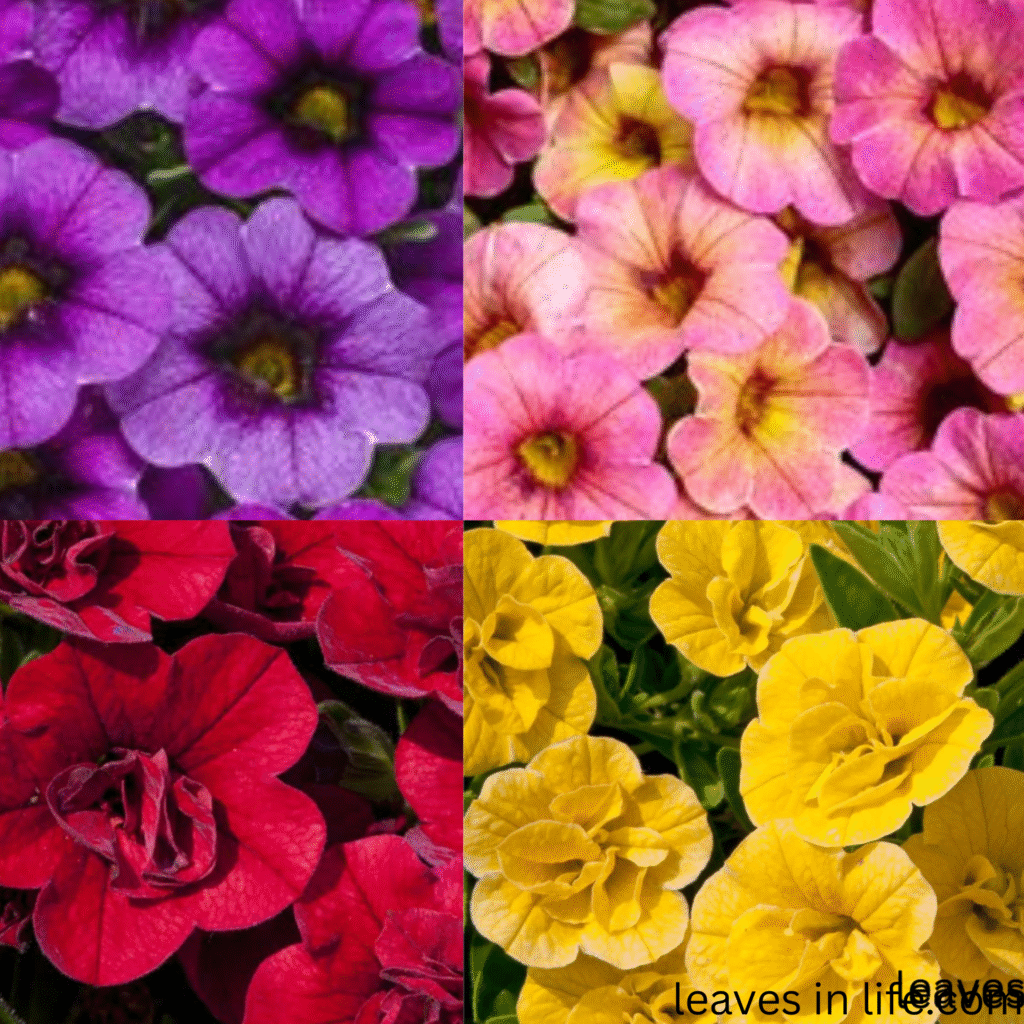
MILLION BELLS (calibracoa)
Zones: Million Bells (Calibrachoa) thrive in USDA Hardiness Zones 9 through 11, usually grown as annuals in cooler zones (versatile across many varieties).
Vibe: Charming, cascading, vibrant, cheerful, playful, festive, delicate, colorful, welcoming, lively.
Varieties: Single-Flower Varieties — Cabaret, Mini-Famous; Double-Flower Varieties — Mini-Famous Double, Super-bells Double; Trailing Varieties — Aloha, Can-Can; Unique/Patterned Varieties — Super-bells Lemon Slice, Candy Bouquet.
Height and spread: Single-Flower Varieties — 6–10 in tall and 12–24 in wide; Double-Flower Varieties — 6–10 in tall and 12–24 in wide; Trailing Varieties — 6–8 in tall and 18–30 in wide; Unique/Patterned Varieties — 6–10 in tall and 12–24 in wide.
Blooming period: Single-flower varieties bloom from spring through fall. Double-flower varieties flower from spring through fall. Trailing varieties bloom from late spring until frost. Unique/patterned varieties flower from spring through fall.
Cascading Colour: Million Bells as Companion Plants for Roses
Million Bells are charming, trailing annuals that make excellent companion plants for roses, bringing cascading blooms and vibrant color to rose gardens. Their delicate, bell-shaped flowers contrast beautifully with rose blooms, creating a layered and dynamic display. Planting Million Bells as companion plants for roses not only enhances visual appeal but also attracts pollinators, supports beneficial insects, and encourages a thriving garden ecosystem, making them a perfect choice for containers, borders, and hanging baskets.
Why Are Million Bells Ideal Companion Plants for Roses?
Million Bells are ideal companion plants for roses because they are low-maintenance, long-blooming, and heat-tolerant, thriving alongside roses without competing for nutrients. Their trailing habit allows them to spill gracefully over edges, adding dimension and softness to rose beds. Million Bells are also pest-resistant, adaptable to well-drained soil, and versatile across many varieties, making them an effortless and visually rewarding addition to any rose garden.
Growing Habits of Million Bells
Single-flower varieties grow 6–10 inches tall and 12–24 inches wide, double-flower types reach 6–10 inches tall and 12–24 inches wide, trailing varieties grow 6–8 inches tall and 18–30 inches wide, and unique/patterned varieties can reach 6–10 inches tall with 12–24 inches wide spread. Million Bells thrive in full sun with moderate watering and provide continuous blooms from spring through fall, making them reliable companion plants for roses.
Best Season to Plant Million Bells with Roses
The ideal time to plant Million Bells as companion plants for roses is spring after frost. Planting during this time ensures vigorous growth, long-lasting blooms, and a vibrant cascading display that complements roses throughout summer and fall.
Top Million Bells Varieties to Plant with Roses
Following varieties of million bells are the best companion plants for roses:
- Cabaret
- MiniFamous
- MiniFamous Double
- Superbells Double
- Candy Bouquet
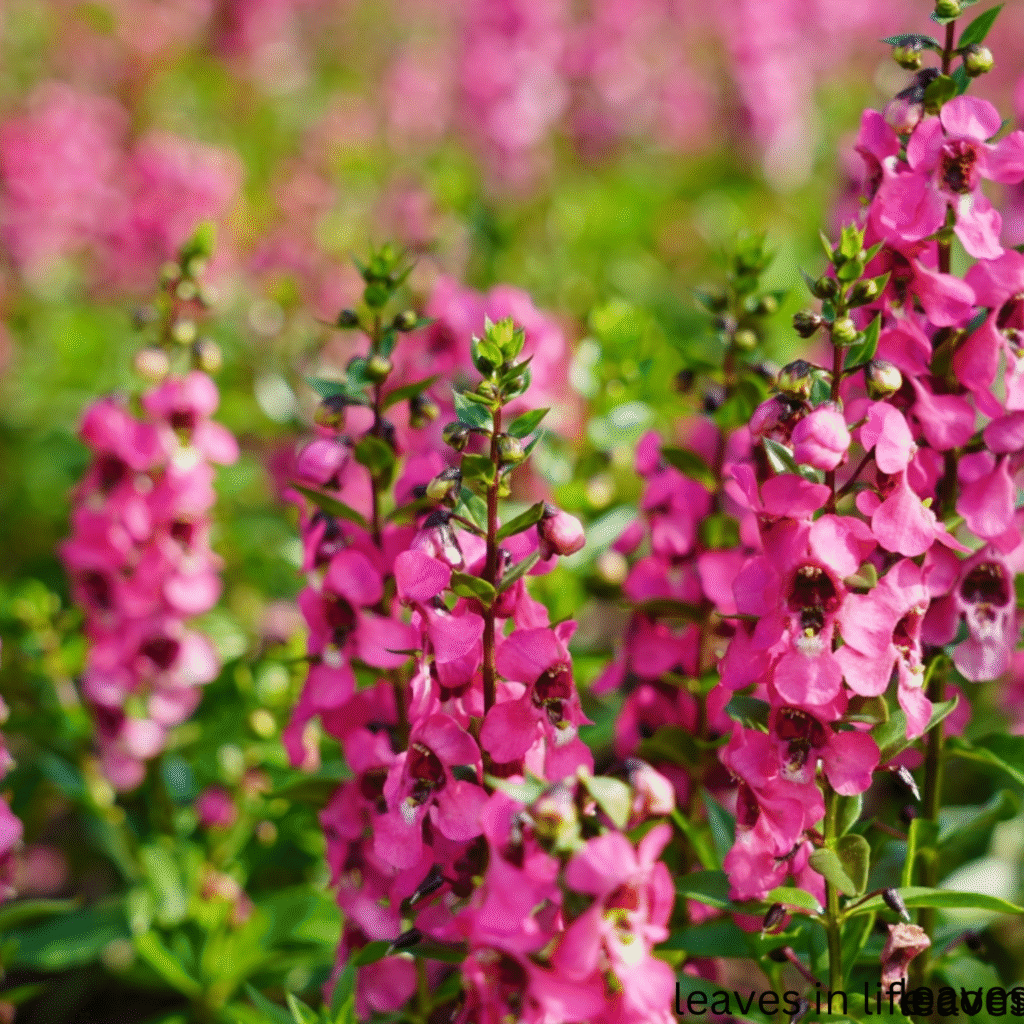
SUMMER SNAPDRAGON (Angelonia angustifolia)
Zones: Summer snapdragons (Angelonia) thrive in USDA Hardiness Zones 9 through 11, usually grown as annuals in cooler zones (versatile across many varieties).
Vibe: Elegant, vibrant, upright, cheerful, sunny, festive, graceful, lively, colorful, uplifting.
Varieties: Tall Varieties — Serena, Carita; Compact Varieties — Alonia, Angel-Mist; Spreading Varieties — Angel-Dance, Archangel; Unique/Colour-Patterned Varieties — Alonia Big Bicolor, Angelonia Perfectly Pink.
Height and spread: Tall Varieties — 18–24 in tall and 12–16 in wide; Compact Varieties — 12–18 in tall and 10–14 in wide; Spreading Varieties — 12–16 in tall and 16–20 in wide; Unique/Color-Patterned Varieties — 12–24 in tall and 10–16 in wide.
Blooming period:Tall varieties bloom late spring–fall. Compact varieties flower spring–summer. Spreading varieties bloom late spring–summer. Unique/colour-patterned varieties flower late spring–frost.
Elegant Blooms: Summer Snapdragons as Companion Plants for Roses
Summer Snapdragons are striking, upright annuals that make excellent companion plants for roses, adding vertical interest and vibrant color to rose gardens. Their spiked, tubular blooms contrast beautifully with the rounded petals of roses, creating a dramatic and elegant display. Planting Summer Snapdragons as companion plants for roses not only enhances garden aesthetics but also attracts pollinators, supports beneficial insects, and encourages a thriving garden ecosystem, making them a standout choice for any rose bed.
Why Are Summer Snapdragons Ideal Companion Plants for Roses?
Summer Snapdragons are ideal companion plants for roses because they are low-maintenance, long-blooming, and heat-tolerant, thriving alongside roses without competing for nutrients. Their upright habit adds height and structure, while the variety of colors — from pinks and purples to whites and yellows — complement rose blooms beautifully. Snapdragons are also pest-resistant and adaptable to well-drained soil, making them effortless and rewarding companion plants for roses.
Growing Habits of Summer Snapdragons
Tall varieties grow 18–24 inches tall and 12–16 inches wide, compact varieties reach 12–18 inches tall and 10–14 inches wide, spreading types grow 12–16 inches tall and 16–20 inches wide, and unique/color-patterned varieties can reach 12–24 inches tall with 10–16 inches wide spread. Summer Snapdragons thrive in full sun with moderate watering and provide continuous blooms from late spring through fall, making them reliable companion plants for roses.
Best Season to Plant Summer Snapdragons with Roses
The ideal time to plant Summer Snapdragons as companion plants for roses is late spring after frost, ensuring vigorous growth, long-lasting blooms, and a vibrant vertical display that complements roses during their peak flowering season.
Top Summer Snapdragon Varieties to Plant with Roses
Following varieties of snapdragon are best companion plants for roses:
- Serena
- Carita
- Alonia
- AngelMist
- AngelDance
“Plants that you should not plant with roses
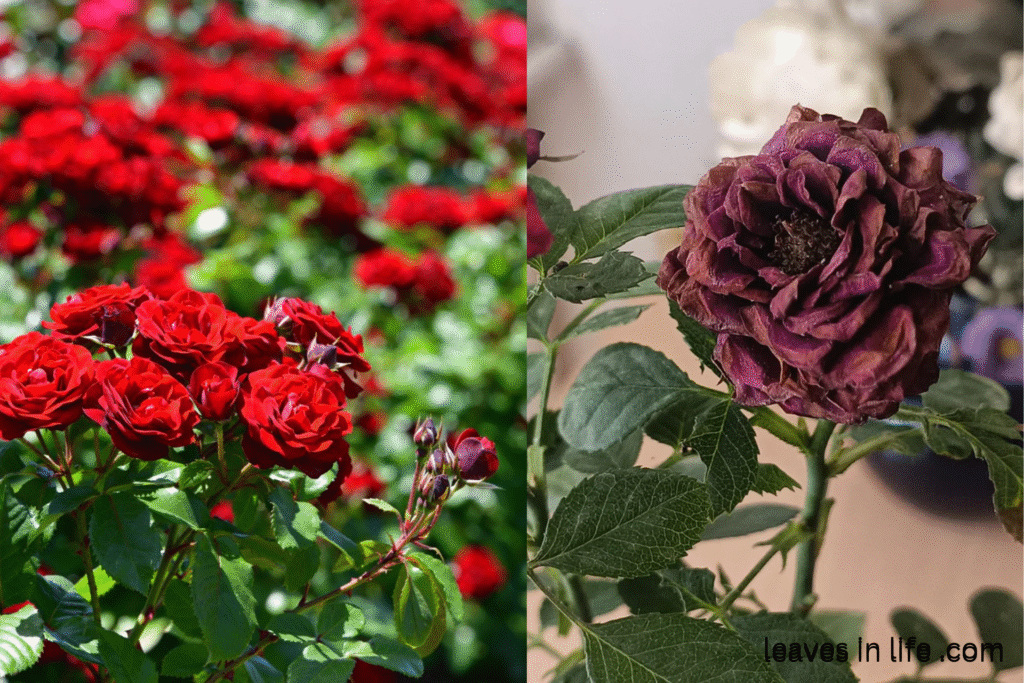
Types
Reason to prevent from roses
Examples
| Plants with extensive or invasive root systems | invasive plants steal resources, crowd roots, and harm growth of roses. | Bamboo, Willow, Poplar, Mint, Horseradish, Silver Maple, Jerusalem Artichoke, Comfrey, Daylily, Sorghum |
| Pest magnets | attract insects and pests, which can then spread to nearby roses, damaging leaves, stems, or flowers, and weaken the overall plant health. | Tomatoes, Peppers, Eggplants, Sunflowers, Sweet Alyssum, Fuchsias, Dahlias, Hibiscus, Geraniums, Petunias |
| Tall, fast-growing plants | shade roses too much, compete for sunlight and nutrients, and overcrowd the garden, limiting the space roses need to thrive. | Bamboo, Eucalyptus, Poplar, Willow, Corn, Sunflower, Sweet Corn, Sorghum, Paulownia, Wisteria |
| Nutrient-competitive plants | Nutrient-competitive plants take up most of the soil’s nutrients, leaving less food for roses, which can weaken their growth, flowering, and overall health. | Mint, Horseradish, Comfrey, Daylily, Sorghum, Corn, Bamboo, Eucalyptus, Poplar, Willow |
| Plants susceptible to the same diseases | Can spread infections quickly to roses, increase the risk of pest attacks, and make disease management much harder in the garden. | Tomatoes, Peppers, Eggplants, Potatoes, Blackberries, Strawberries, Grapes, Fuchsias, Hibiscus, Nasturtiums |
| Plants requiring moist or boggy soil | demand more water than roses, which prefer well-drained soil, creating unsuitable growing conditions and increasing the risk of root rot for the roses. | Cattails, Marsh Marigold, Iris (Bog varieties), Gunnera, Ferns, Calla Lily, Papyrus, Taro, Water Forget-Me-Not, Sweet Flag |
| Shade-loving plants | thrive in low light, so planting them near roses can create excessive shade, limit sunlight for rose growth, and reduce flowering and overall health. | Ferns, Astilbe, Lungwort, Heuchera, Begonia, Impatiens, Coleus, Solomon’s Seal, Tiarella |
“Conclusion”
I’ve discovered that choosing the right companion plants for roses makes a huge difference in how healthy and vibrant they grow. The right companions not only enhance the beauty of my garden, but also attract helpful pollinators, repel pests, and add colour and texture that complement the roses. At the same time, I avoid plants that compete for nutrients, block sunlight, or attract harmful insects, because they can quickly affect rose growth and flowering.
By thoughtfully selecting companion plants for roses, I’ve noticed they bloom fuller, stronger, and more fragrantly than ever before. I highly recommend that anyone growing roses takes a little extra time to plan their companions—it’s incredibly rewarding to see the garden flourish, knowing each plant supports the other. The right companion plants for roses, make gardening not only easier but far more enjoyable.

